Disclaimer: This post contains affiliate links to handpicked partners, including tours, gear and booking sites. If you click through or buy something via one of them, I may receive a small commission. This is at no extra cost to you and allows this site to keep running.
Nature in Latvia is both abundant and preserved, and the discovery of its best spots can be easily accessed when visiting Gauja National Park, in a ring of green sites close to the capital, Riga. Here’s where to go and what to do.
Gauja National Park is the largest national park in Latvia and a protected area set up in 1973 to preserve the area’s huge biodiversity and geologically diverse terrain. Named after the Gauja River that flows through it, almost half its 90,000-hectare surface area is comprised of unspoiled forest, where 900 plants, 140 bird and close to 50 mammal species thrive within.
Primarily a nature reserve, filled in with 350 million-year-old red-orange rocky outcrops and sandstone cliffs, verdant valley beds and tempting lakes, Gauja National Park is also an area people visit for its hotspots of historical and cultural significance.
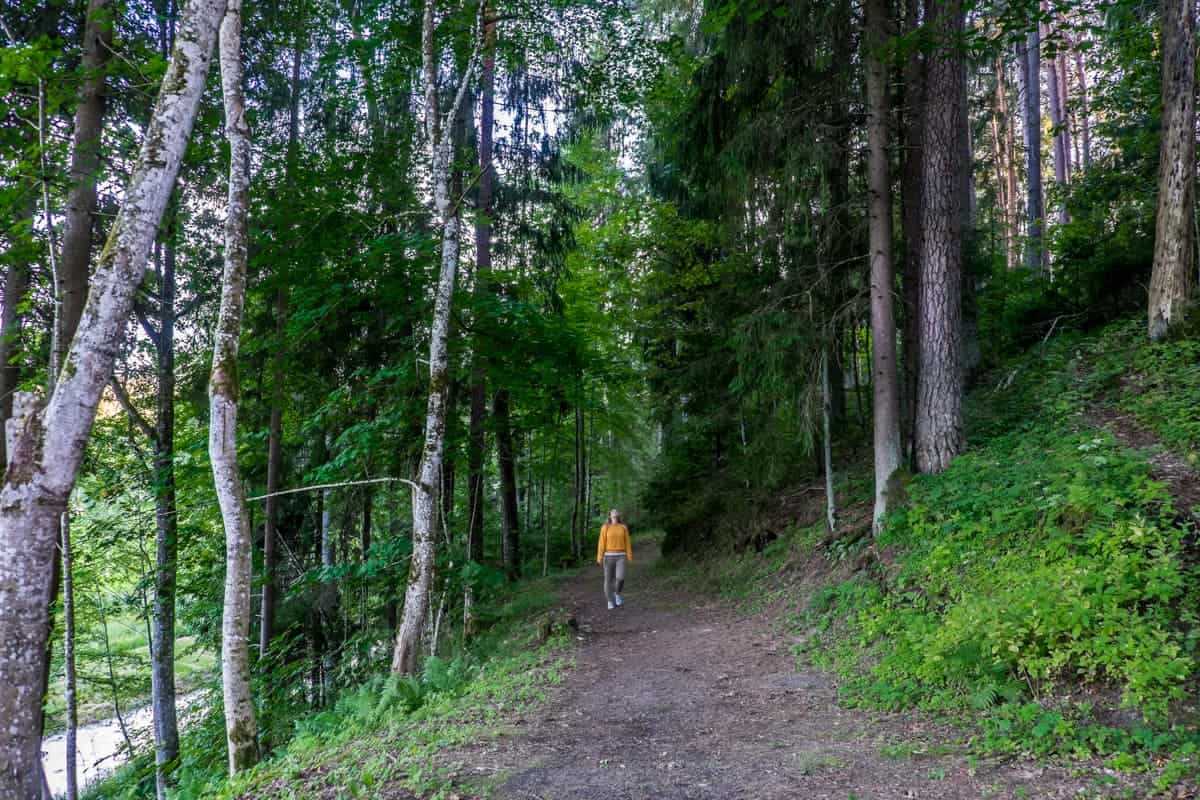
Gauja National Park – Finding Cultural Heritage and Adventure in Latvia Nature
Because of that, the overwhelming amount of things to do in Gauja National Park can be hard to narrow down, and so we choose to explore Līgatne, Vidriži, Ērgļi, Cēsis and Sigulda in five days to see the best of this sightseeing mix.
Combining nature and adventure activities with cultural monuments and historic towns of interest, we explored history in secret Soviet Bunker and castle visits, centuries-old culture and traditions in ceremonies including a Latvian bath ritual and the nature trails, forests, lakes, caves and the Great Oaks Hike that make up the wilderness of this special region.
This overview will give you a good starting point on how to visit Gauja National Park on a road trip with a well-rounded plan, whether you have one weekend or one week.
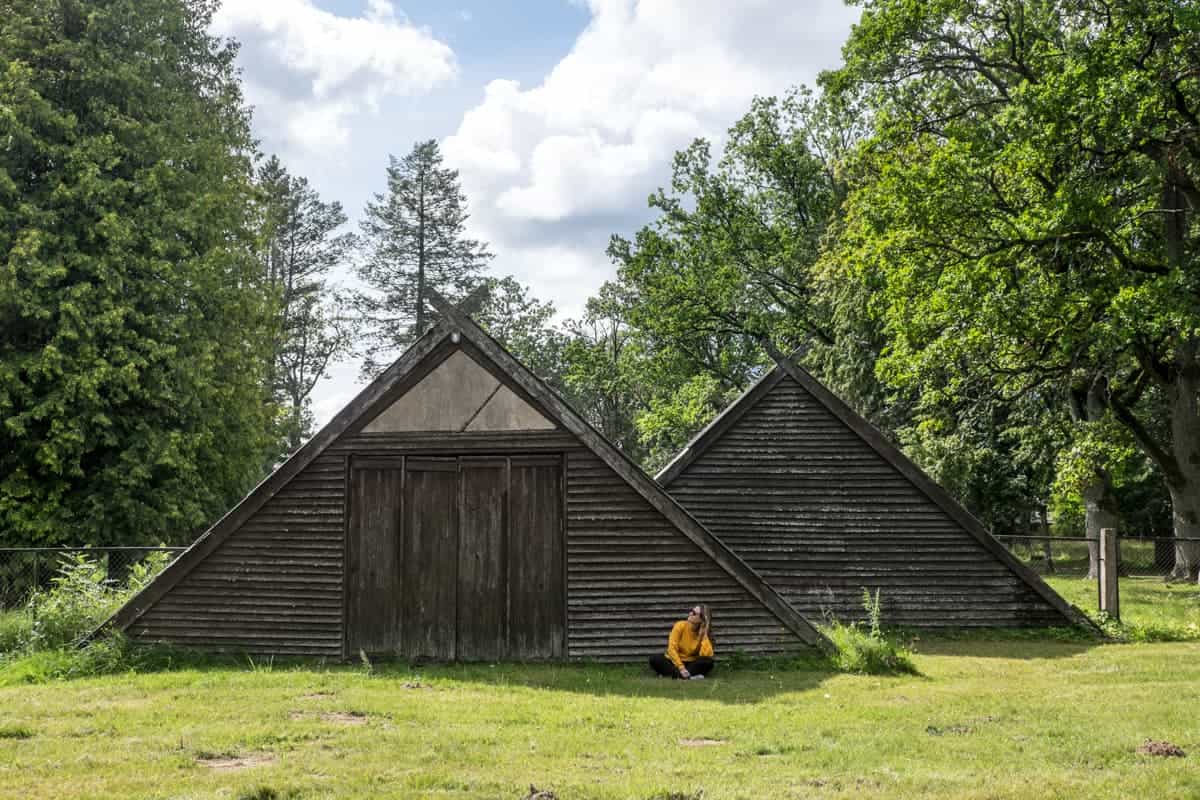
The wooden triangular structures found in the nature of Sigulda, Gauja National Park
Contents
What to Do and Where to Go in Gauja National Park
The following trip to Gauja National Park and the planning of the itinerary following our interests and timings was in conjunction with Magnetic Latvia (the Latvia tourism board) whom we partnered to showcase the best of Latvia’s nature.
Līgatne
Līgatne is a peaceful, historic town that sits within Gauja National Park. The drive to Līgante from Riga draws you into pristine farmers’ fields, cut by small gravel roads flanked by grand, aged trees.
Notably, it’s an outdoor enthusiast’s space not far from the city, where you can get lost within the pathways that mark out the Ligatne Walking Trails. Or find yourself in pockets of dense forest and resting beside peaceful water spots.
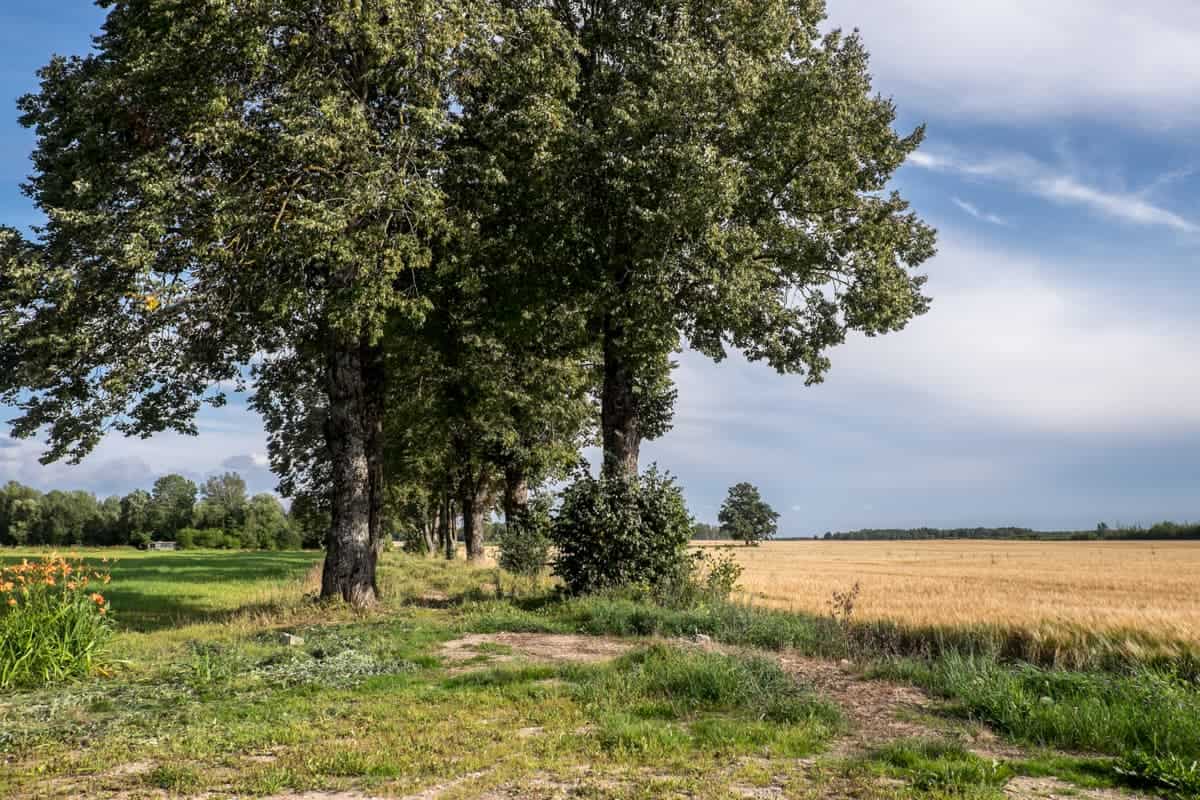
A road trip in Gauja National Park, Latvia takes you through scenery like this
Ligatne Nature Trails and Caves
The Ligatne Nature Trails are not an arduous trek, but a light hiking trail around 4km long that take up to two hours, depending on your speed as well as how much you stop to observe the animals and lose yourself in the forest arches, which you might have to yourself. The Trail in Lignates follows the walls of red-washed sandstone cliffs to elevated viewpoints.
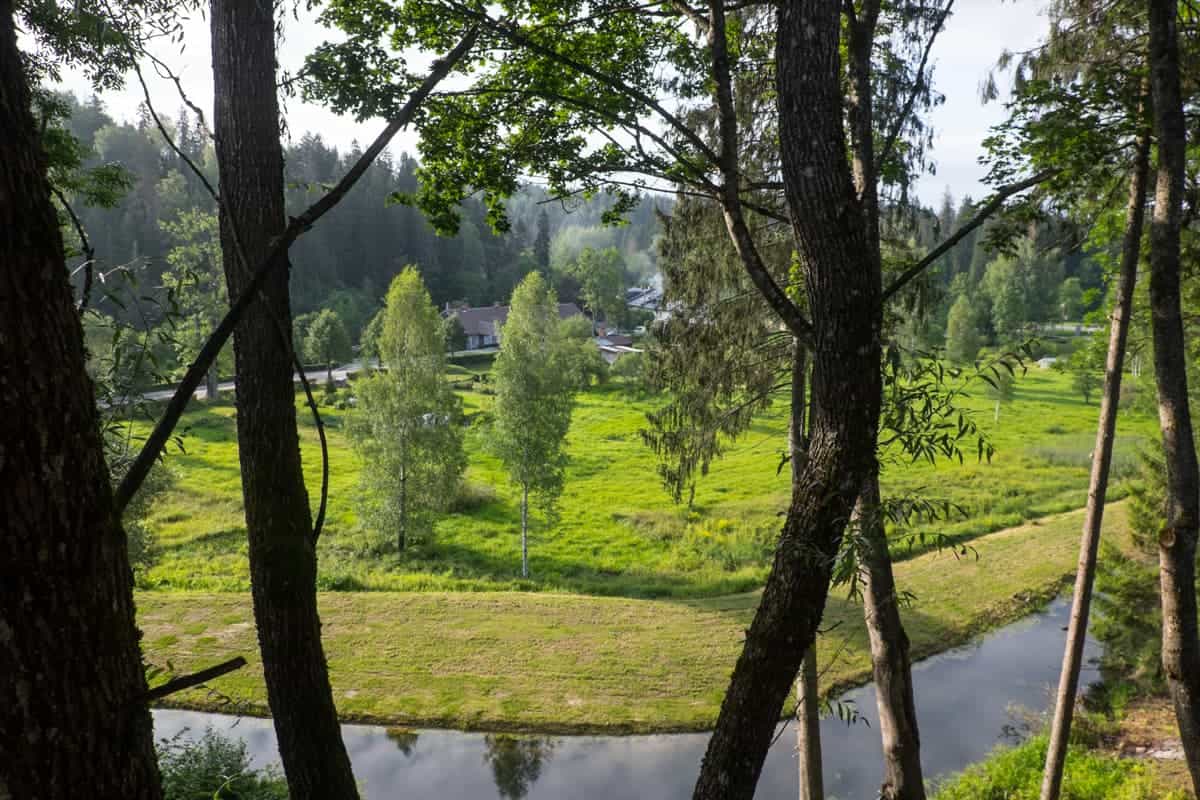
Nature valley views as seen on the Līgatne nature trails
Nature may still dominate the former paper mill village and run a trailed loop around it, but some of the former buildings still stand. Others, like the Hotel Zeit, are repurposing old factories into accommodation space and healthy restaurants and cafes using locally sourced produce.
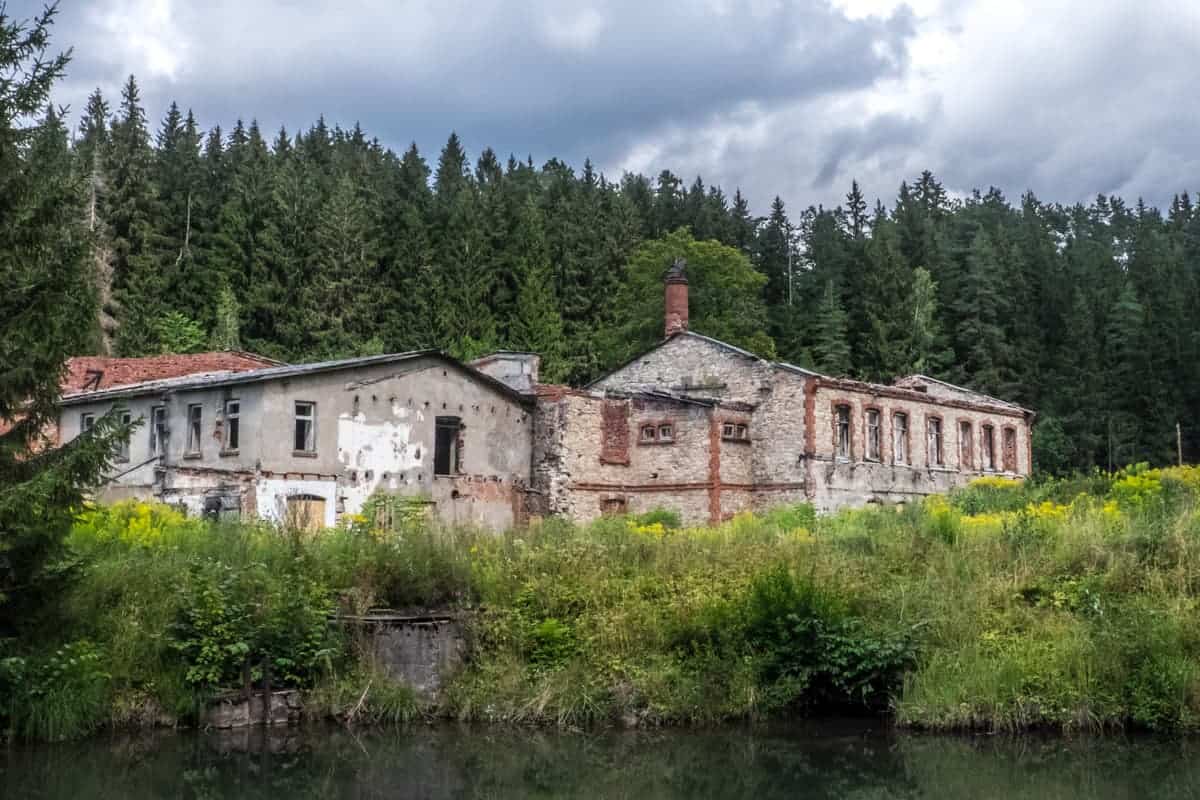
Ligatne is known as the former paper mill village, where old structures still stand
On the historical walking trail of the village – worth saving at least half a day for – you are likely to stumble upon the legendary Ligatne Caves, whose carvings and corridors are the living tales of the village.
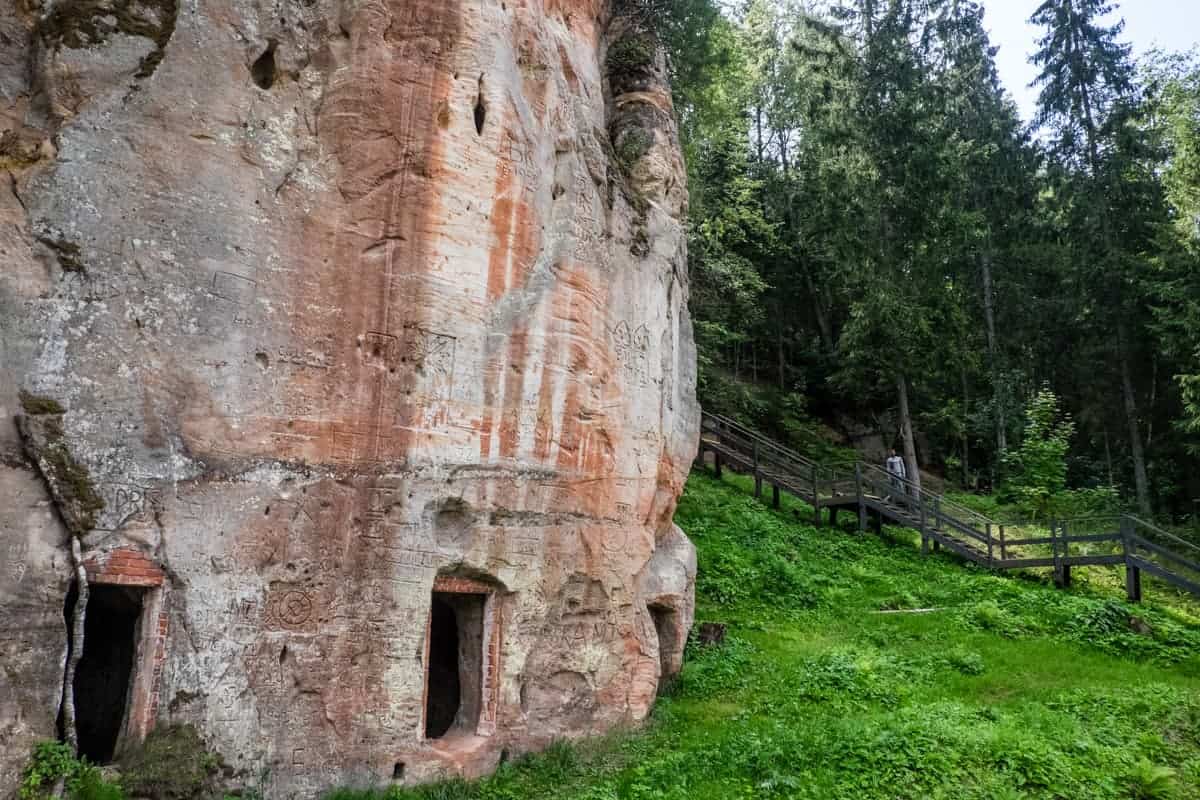
The mysterious doorways and carvings on the Ligatne Caves in Gauja National Park
The Ligatne Basement Cellar Caves and rock highlights such as Lustūzis and Anfabrika cliff are protected sites with national importance. The 300 cellar caves were created by those working at the Paper Mill who dug them out of the sandstone cliffs and the stand today as a testament to the village industry history and where you can go and sample local rhubarb wine.
Experience a Traditional Latvian Sauna
Bathhouse tradition in Latvia is more than just a sauna to cleanse the body. A Latvian Pirts is also a place where you go to cleanse your mind and soul. We drove to the Lígatnes Zemturia campsite in the Ligatnes region, where the bathhouse was located. We also stayed here overnight, as you need to fully relax after the sauna.
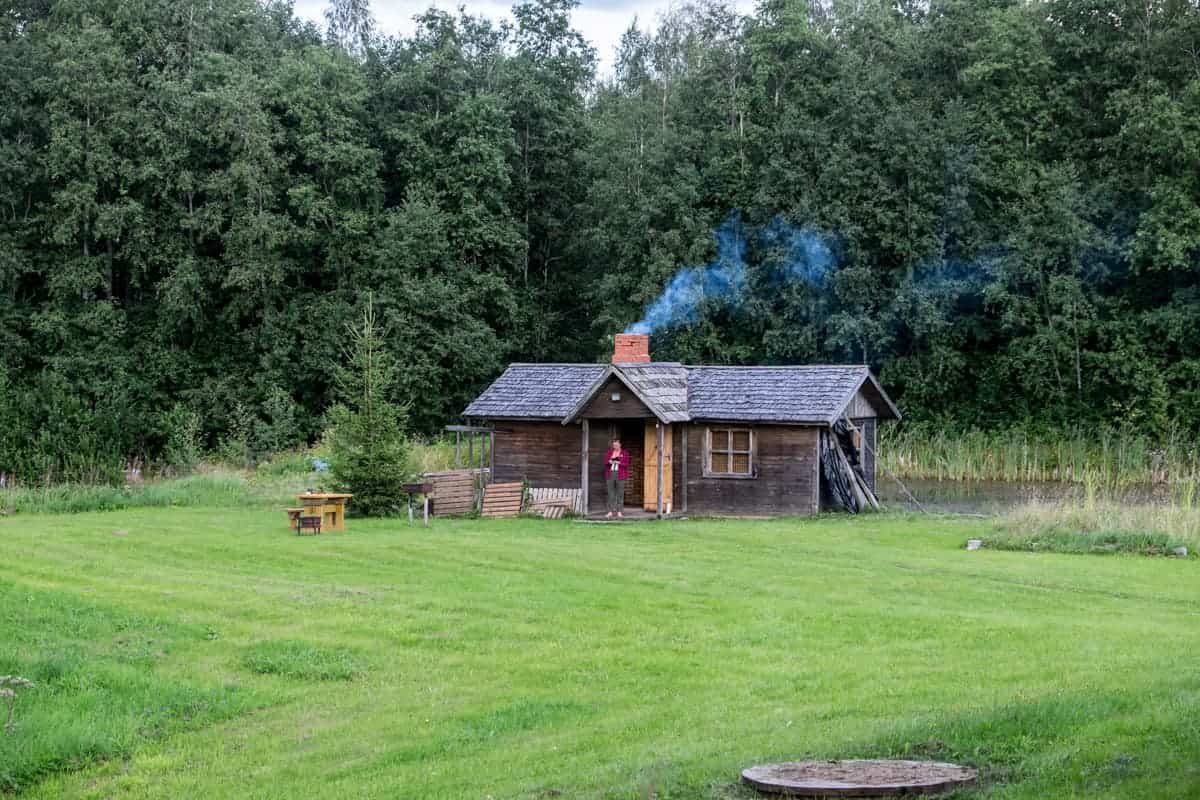
The Bathhouse tradition in Latvia nature is more than just a sauna. It’s a soul cleanse that should be experienced
Nature is the best healer and here, heat and steam, combined with the use of various plants and herbs used on the body, heal the body in various ways, combined with bathing in a cold water pool after. This is a back-to-back process that lasts around four hours.
Importantly, the ‘Bath Wife’ explains the history of the tradition and the typical process, as well as what plants and herbs are used to you before you go to the sauna to begin the cleansing ritual. Since I’m more of a rational person than I am spiritual, I did go into this with the view that it would be an intense sauna.
Except it’s a powerful, therapeutic experience and it became something I will always find hard to ever express clearly because it’s so deeply personal. How this woman was able to ‘read’ me; how she was able to draw out the biggest emotional pain of my life (without knowing anything about me) and slowly and gently allow me to grieve and find more closure with it; how my body was shaking as the plants and herbs works their magic; how I cried when that pain was realised and spoken of deeply.
During a Latvian Bath Ritual, you are at your most vulnerable if you allow yourself to be, and with that, this experience can shift your emotional consciousness.
This traditional Latvian bath ritual experience was organized via The Latvian Element, which has direct contact with the Bath House at the campsite and can arrange a booking for you.
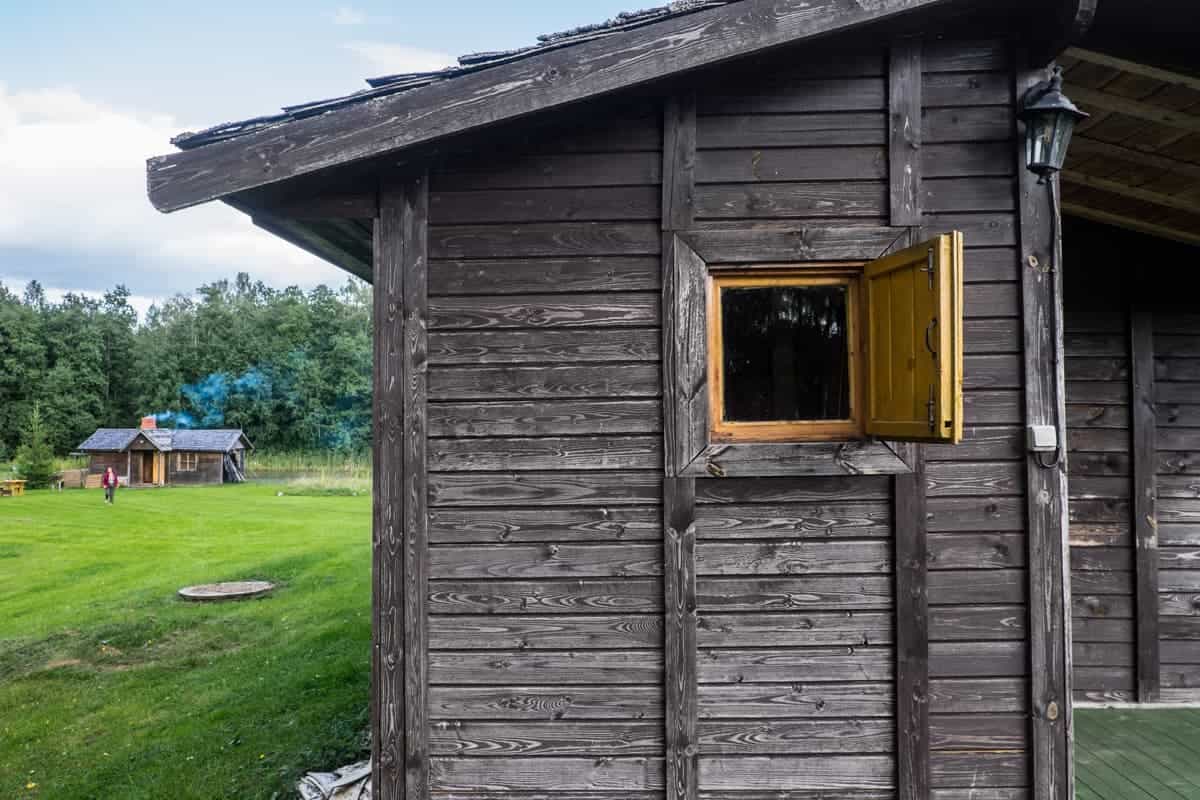
Our wooden hut accommodation at the campsite, close to the traditional bathhouse where we could rest after the four-hour ritual
Zvartes Rock and Hike the Amata Trail
We found Zvārtes Rock – one of the most picturesque nature spots in Latvia within a canvas of valleys, rivers, and sandstone and dolomite cliffs.
Hiking in Gauja National Park is possible, with well-signed routes that help keep to the geological preservation of the area, especially concerning the Amata – the fastest flowing river in Latvia that winds through the valley.
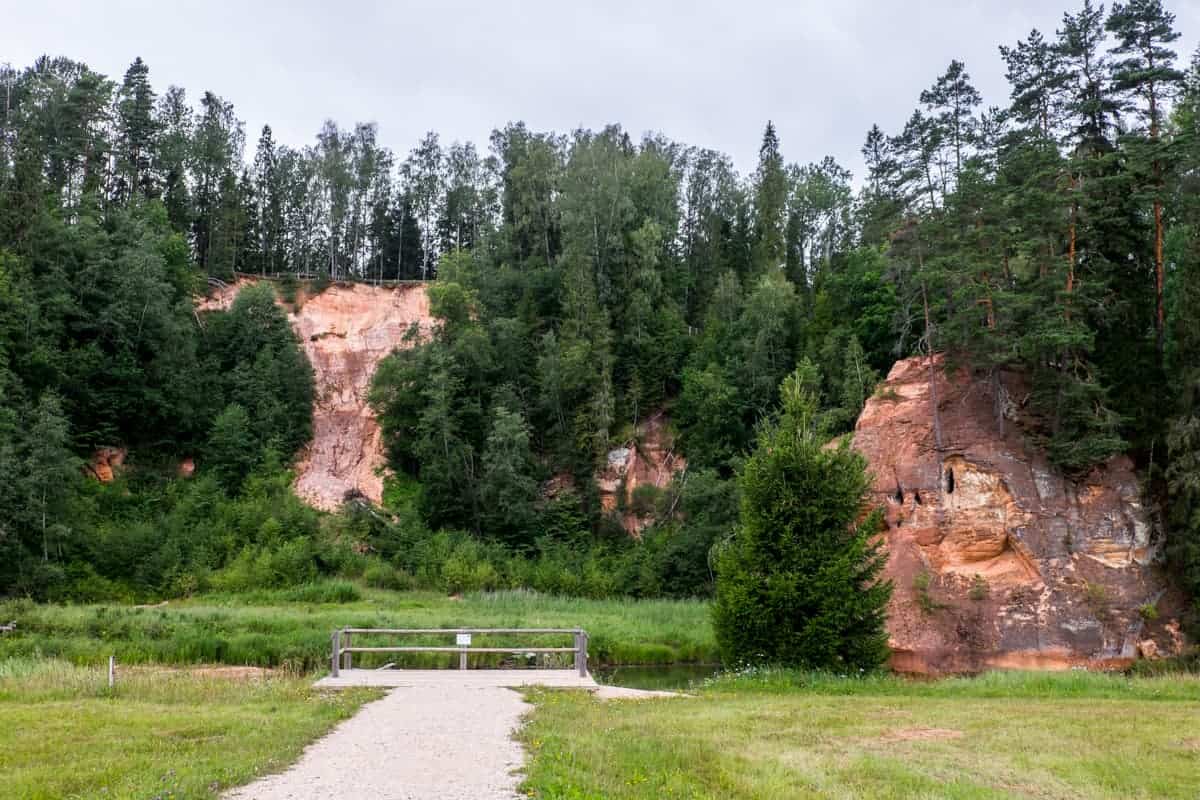
Zvartes Rock – the most famous of all the rocks in Latvia
The Amata Trail is a 12 km path that runs alongside the River – a four to five-hour endeavour that starts at Hotel Karlamuiza or from the bridge on the Vidzeme highway in Melturi and ends at the Veclauču Bridge.
It takes you away from the Vidzeme highway, passing through dense patches of forest and tiny villages, amassing the scenery of the much-loved rocks – Ķaubju, Dzilnas, Lustūzis and, of course, the famous Zvartes. This route is not suitable for bikes.
Soviet Bunker Visit
A reverse from being in the outdoors by going underground, the Soviet Bunker in Ligatne is a significant part of Gauja National Park’s landscape. The secrecy grading was only removed in 2003 as Latvia prepared to join the EU and now serves as a museum, open twice a day at 12:00 and 14:00.
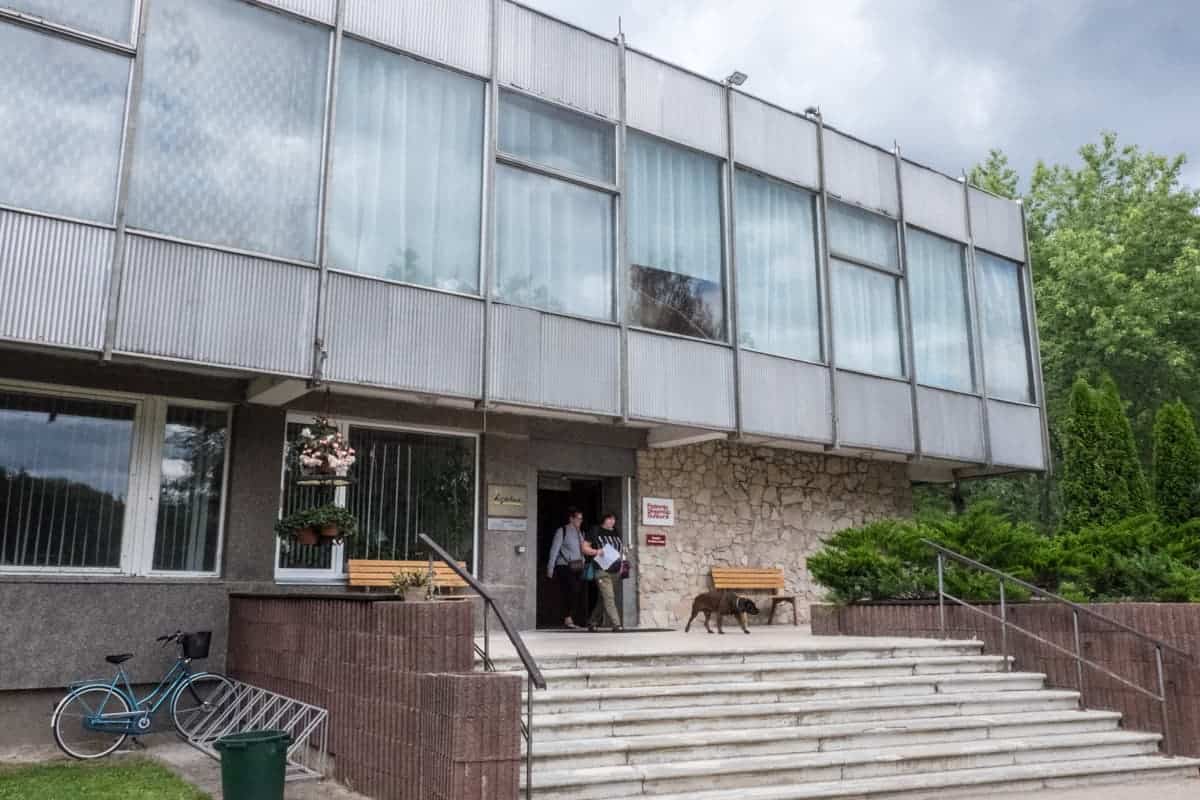
The medical building, which sits above the Soviet Bunker in Latvia
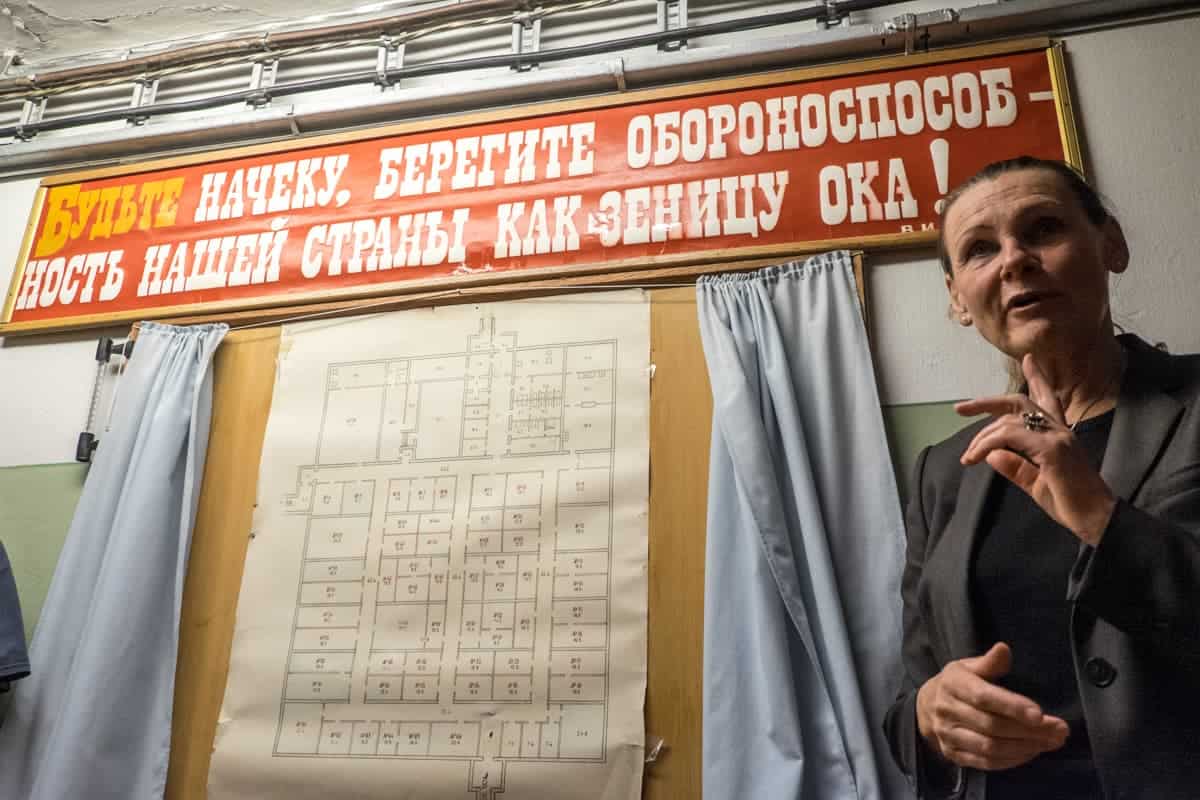
Map of the Soviet Bunker in Latvia, where you view a series of rooms on a guided tour
To understand Latvia, it’s important to get to grips with its darker periods of history and occupation. Independence was achieved in 1918 following time under Germany’s control in WWI, but only for a short while. In 1940, the Soviet Union occupied Latvia and then was occupied by Nazi Germany in 1941-1944, before the Soviet Red Army returned in 1944 to reclaim power until 1991.
A visit to the Soviet Secret Bunker is a part of this history where you will tour various meeting rooms and corridors as they found them intact, as well as see the direct telephone line to Moscow.
A fully equipped facility, 9m underground, covering a total area of 2,000 square metres, it was built to protect the political and state elite during the 1980s in case of nuclear war.
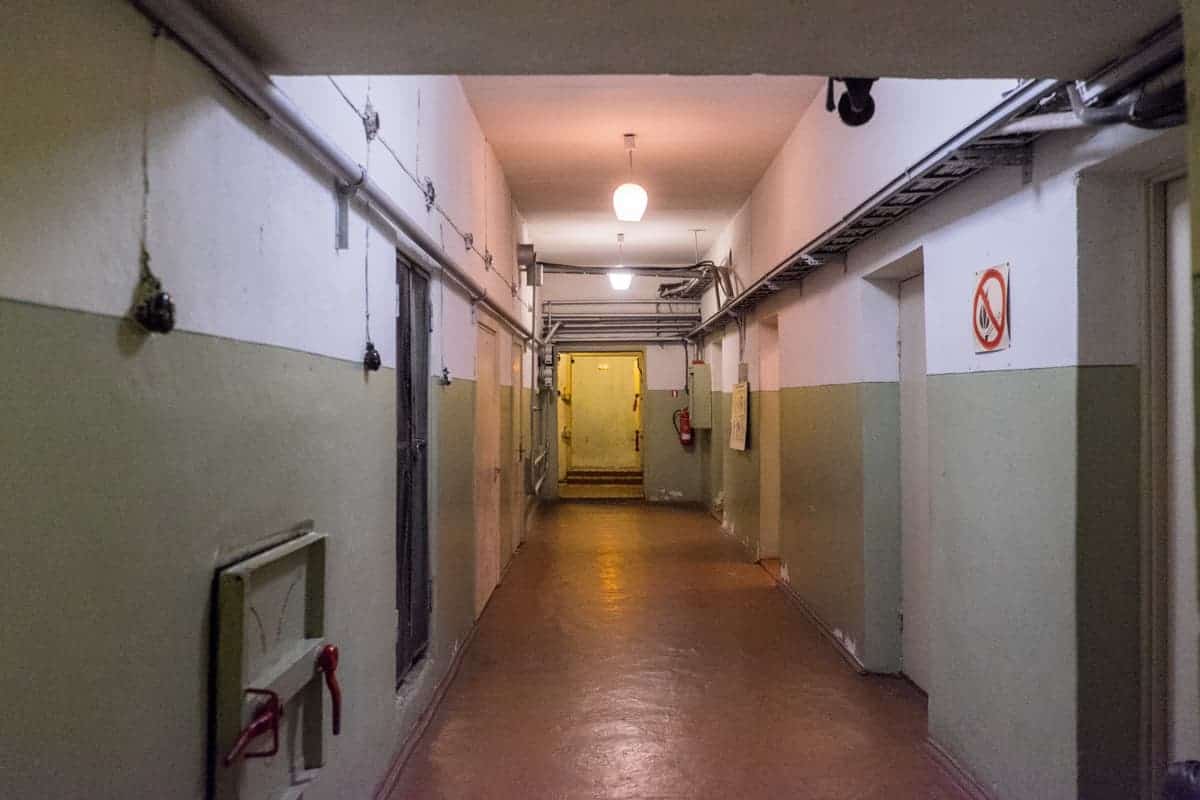
The long, stark, eerie corridors in the secret Soviet Bunker
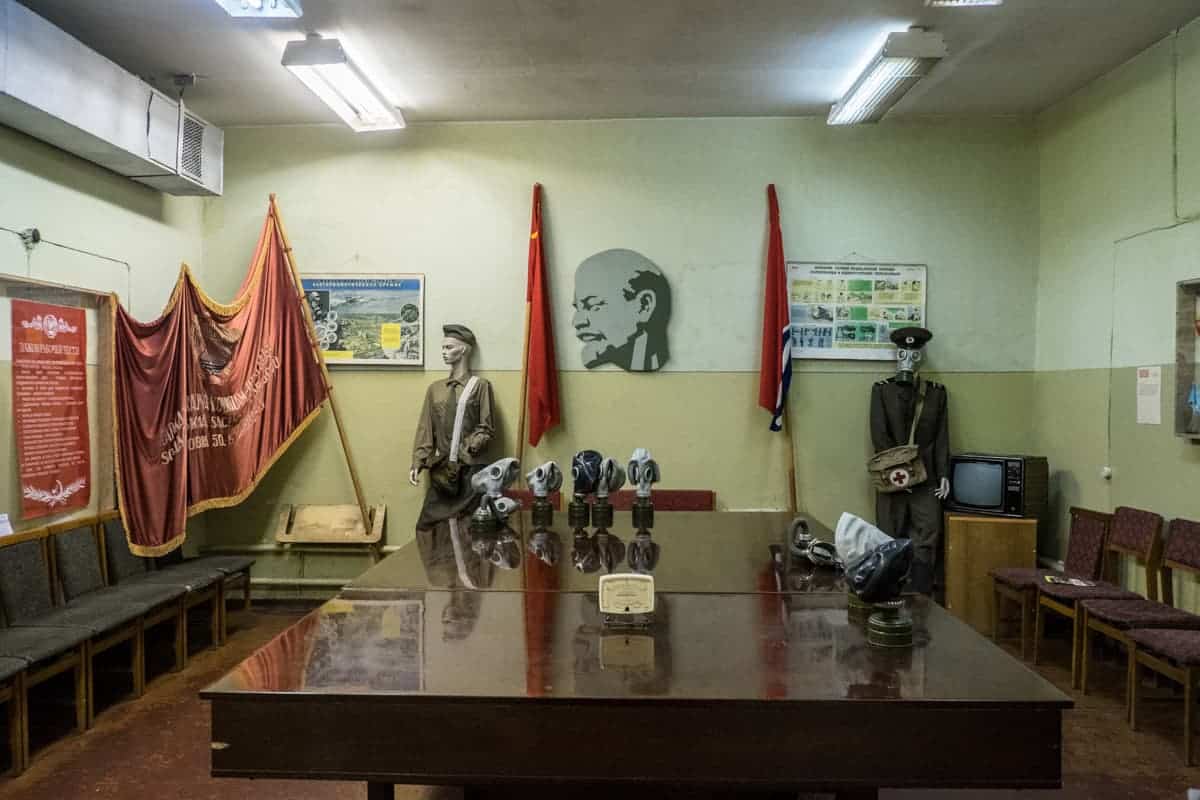
Meeting rooms in the Soviet Bunker, with items that were found there on display
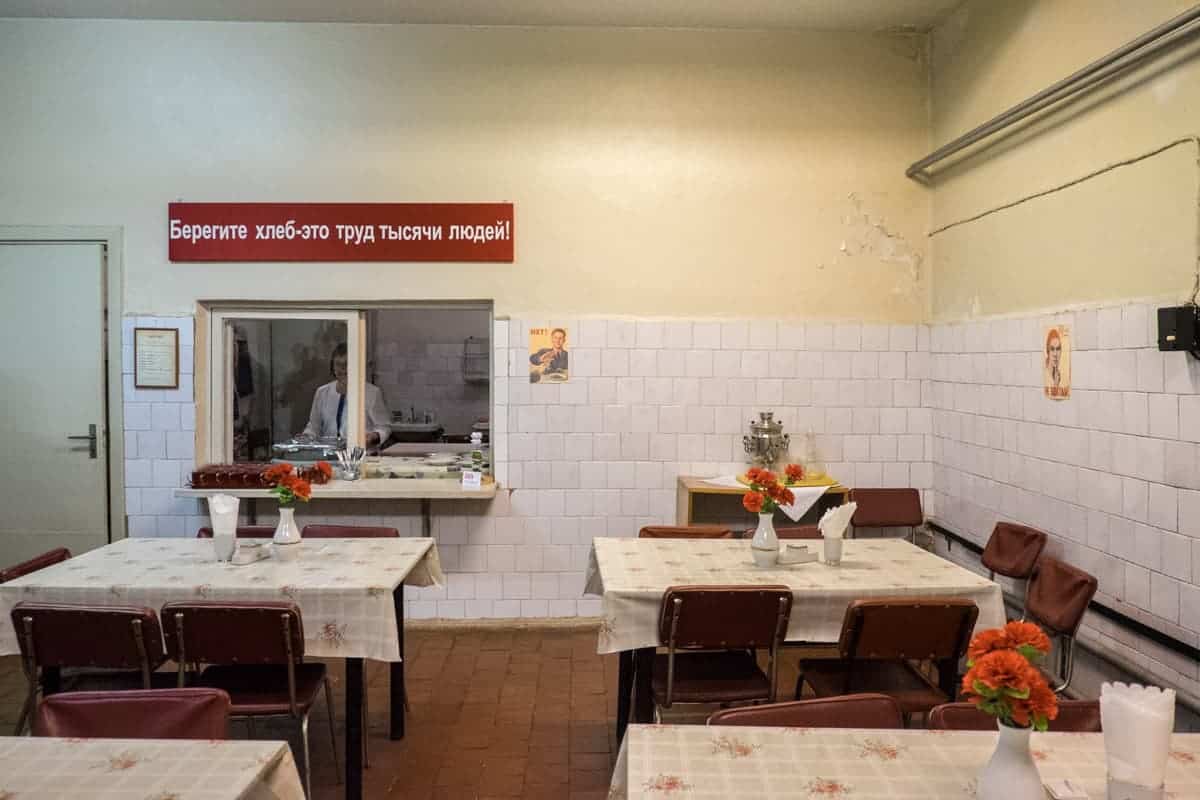
The Soviet Bunker canteen, where you sit and have a snack as part of the Soviet Bunker tour in Latvia
Vidriži (North of Līgante)
We drove to Vidrizi for two experiences that would bring us closer to Latvian folklore and centuries-old traditions. While not geographically within Gauja National Park, Vidriži is best combined with Ligatne, which it neighbours to the north.
Latvian Fire Ritual
In a small field surrounded by oak trees and delicate flowers, we participated in an experience that would show us what a Baltic Tribe Fire Ritual looks like, with healers who see themselves as fully connected with nature and able to understand the natural phenomena associated with Latvian mythology.
Our first task was to pick flowers, which we would place in the outer ring circular fireplace, before helping to construct a grid framework from wood in the middle. Once the fire built to full flame, we would scoop the smoke in our hands and release it to the sky, listen to the chants of the healers, and try to release our worries and impart our wishes onto nature, whereby it would be carried into the sky.
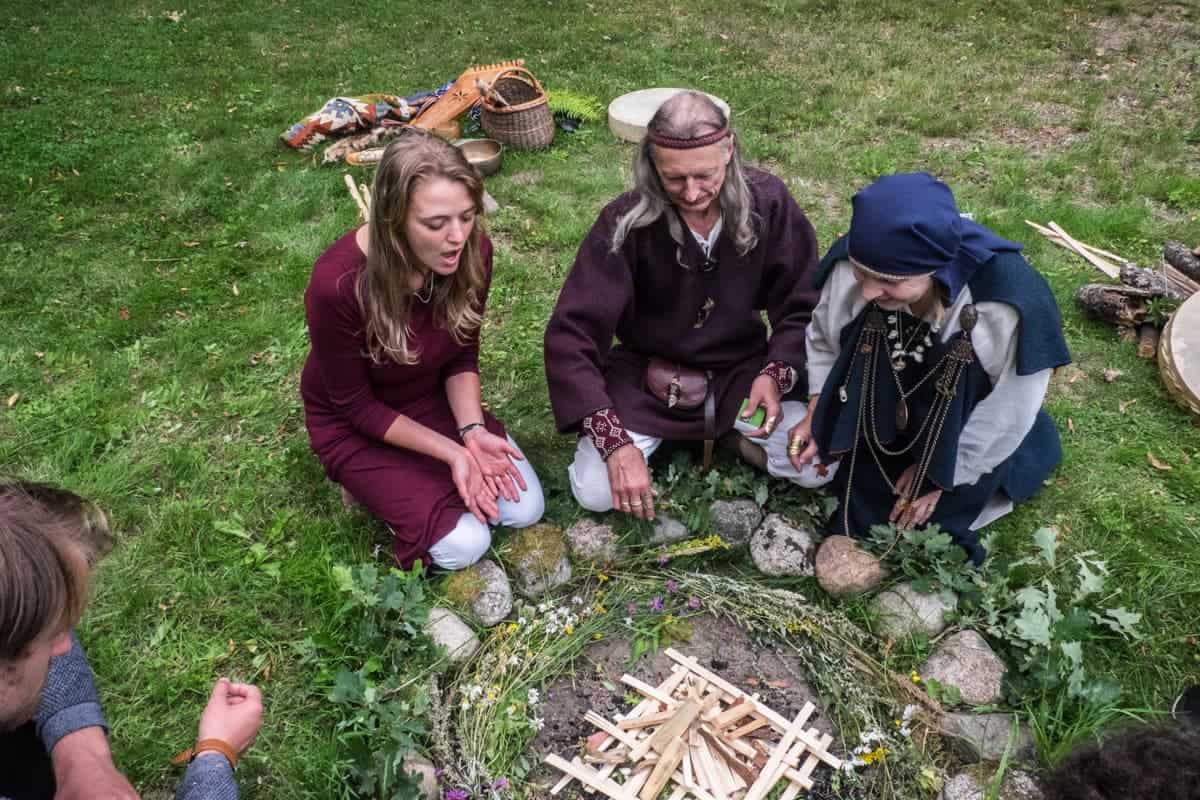
The flower rings and wood stick stack mark the start of the Latvian fire ritual
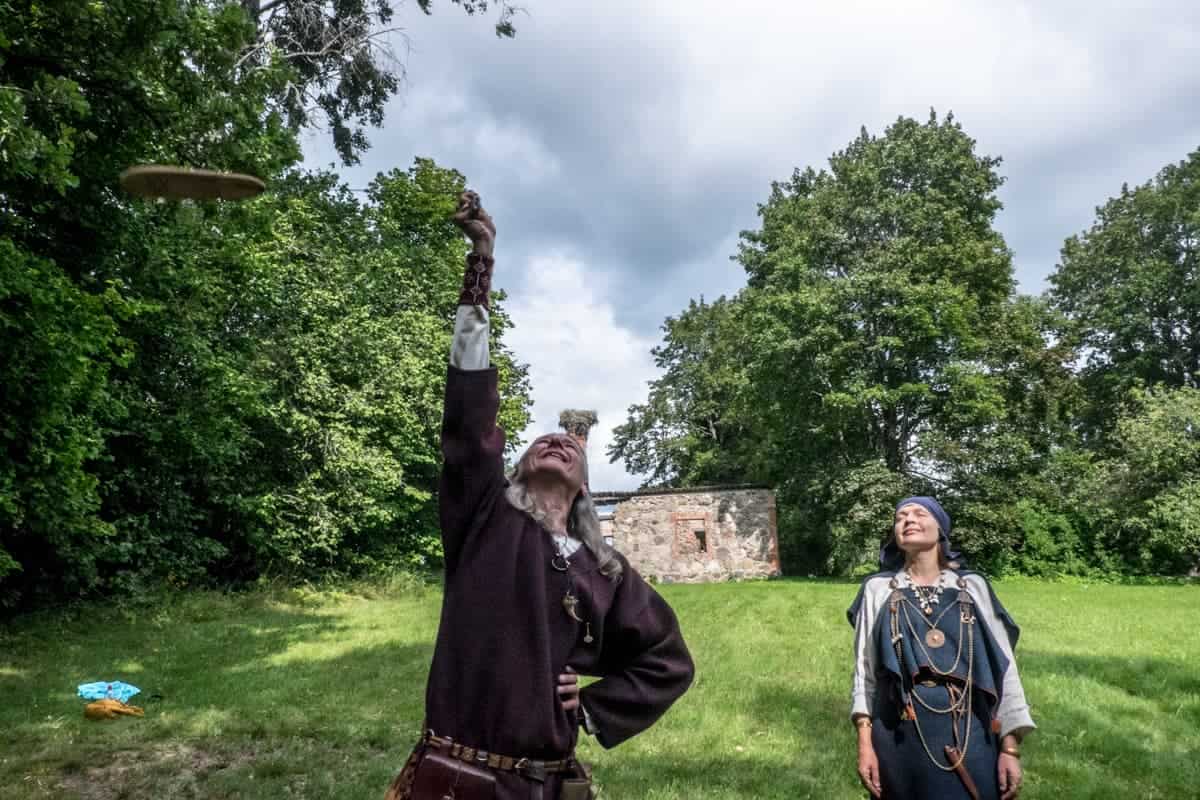
The nature healers perform a ritual to the skies
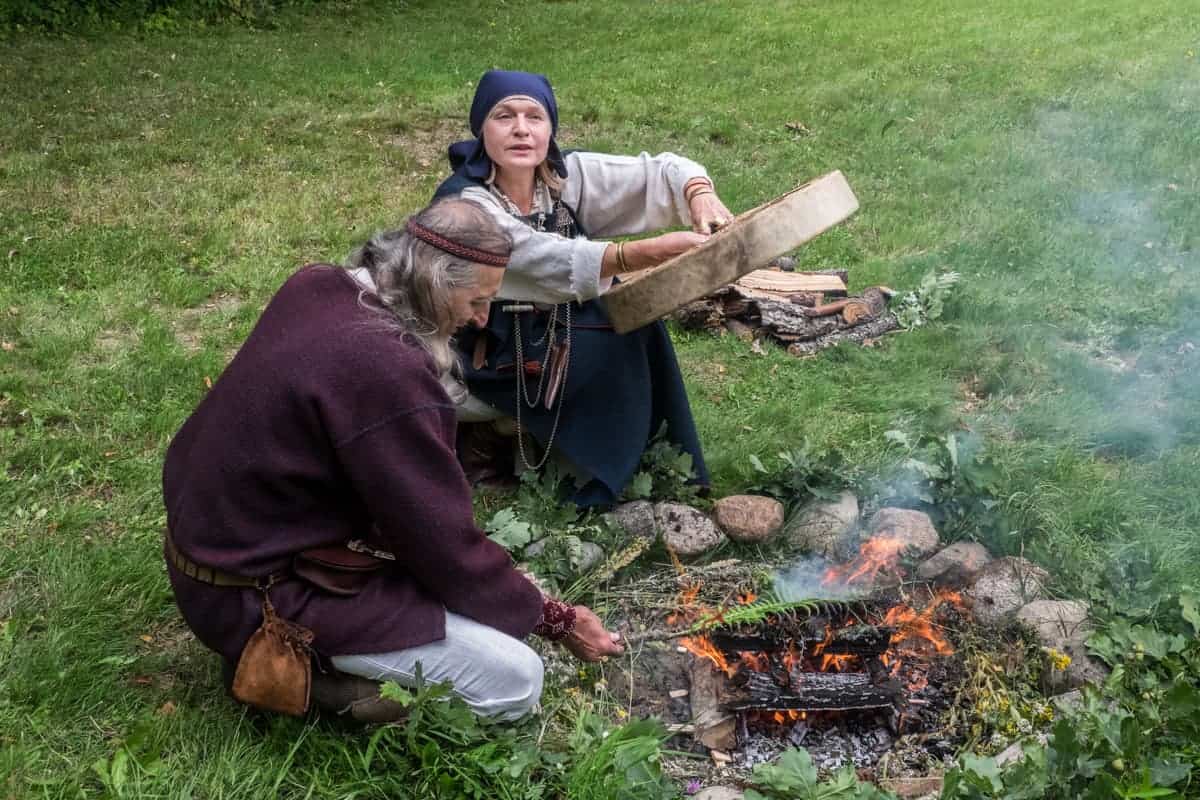
Learning about the process of the Latvian fire rituals in Gauja National Park
While this was not something I felt I got into or had any deep connection with it, it was an interesting way to see this tradition and the process of how these people like to connect the physical and the spiritual.
You can only then imagine what atmosphere is present when hundreds of healers are practising this together simultaneously during the eight times of the year these grand rituals happen and at personal ceremonies for different stages of life. The Summer Solstice is the largest and most well-known of all the rituals.
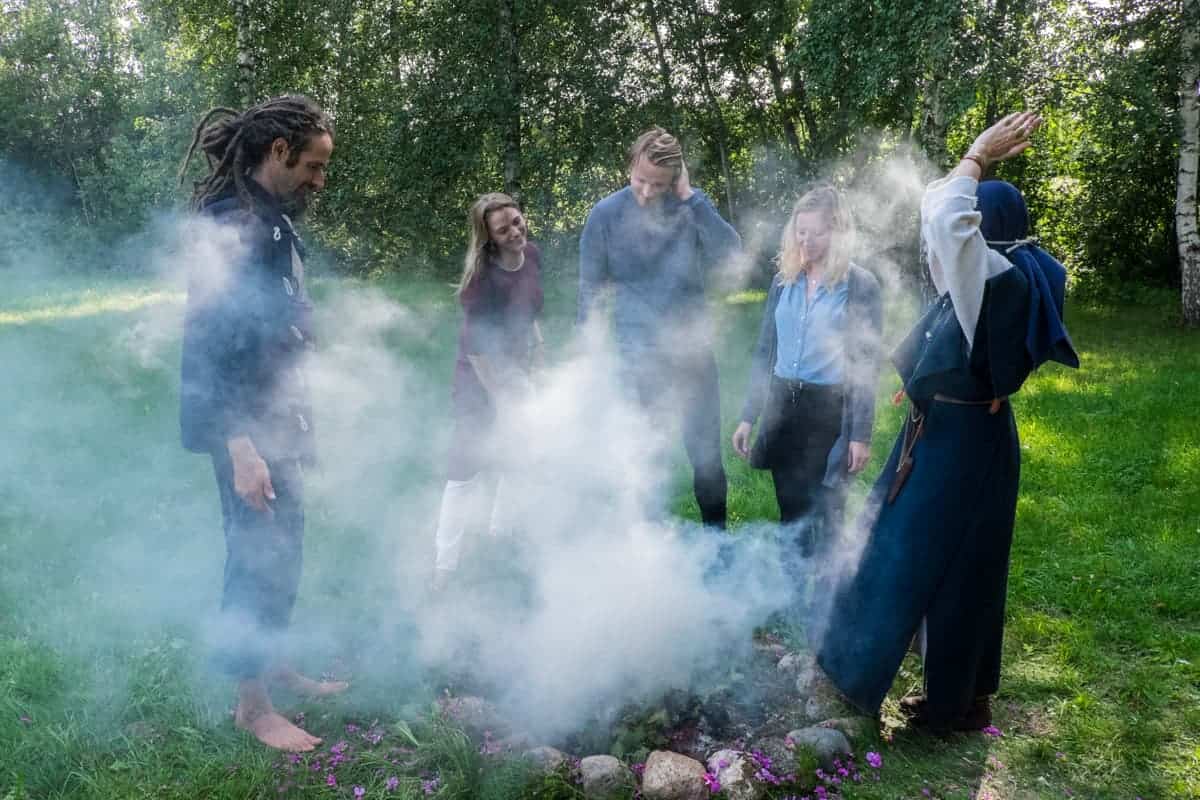
Lifting the smoke to the skies and receiving energy from nature during the fire ritual experience
The Grand Oaks Hike
This hike is one to try for those wanting to have more of an immersive walk in nature and to try and feel the power of connection to nature.
The farmer of the grain fields here in Vidrizi, Latvia, permitted a single, sign-posed, marked path to pass through his fields as part of an official Grand Oaks Hike route. He did so because he wanted to help raise awareness of Grand Oaks in Europe and that these trees, some of which are over 500 years old, should be protected and shared.
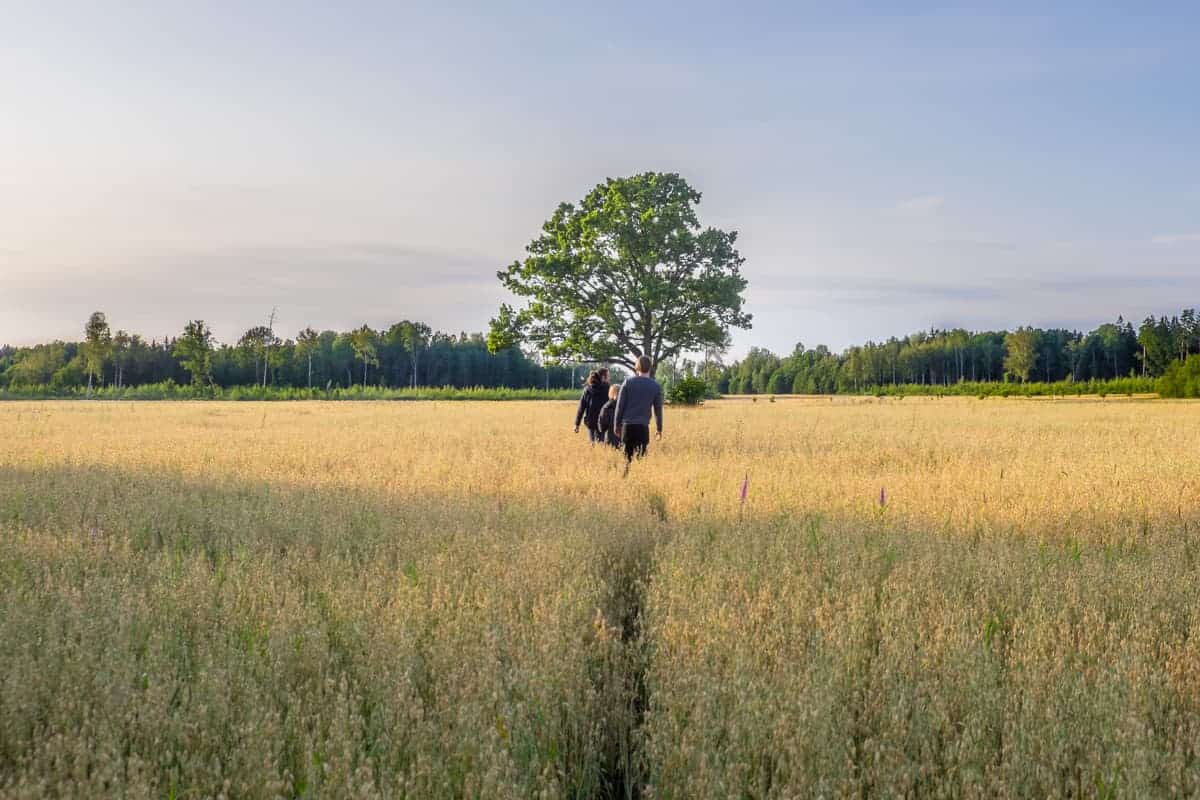
Walking on the permitted, straight-line path through the grainfields on the Latvia Grand Oaks Hike
These timeless trees are common in Latvian folk songs and stories as a symbol of power. At each stop, you are encouraged to hug the trees, not only to get a sense of their momentous size but to try and feel their strength.
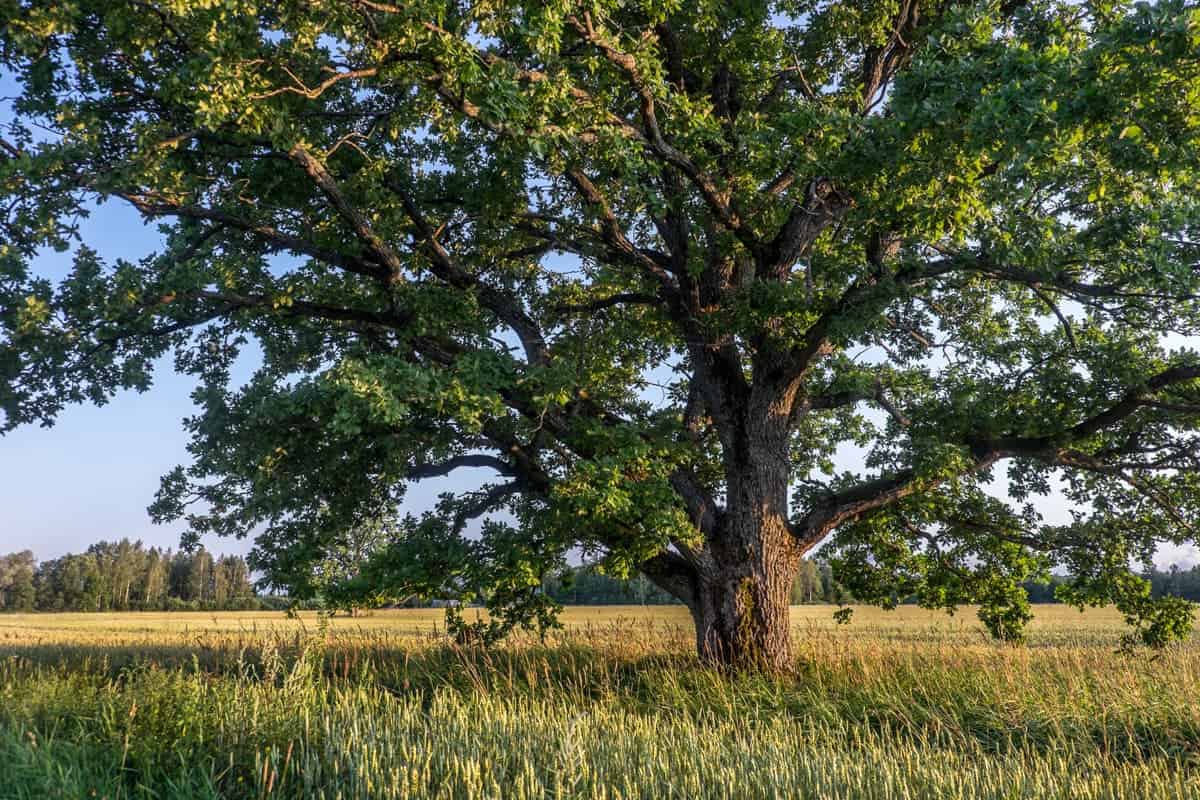
The incredible, ancient Grand Oaks of Latvia, found in the farmlands and forests of Gauja National Park
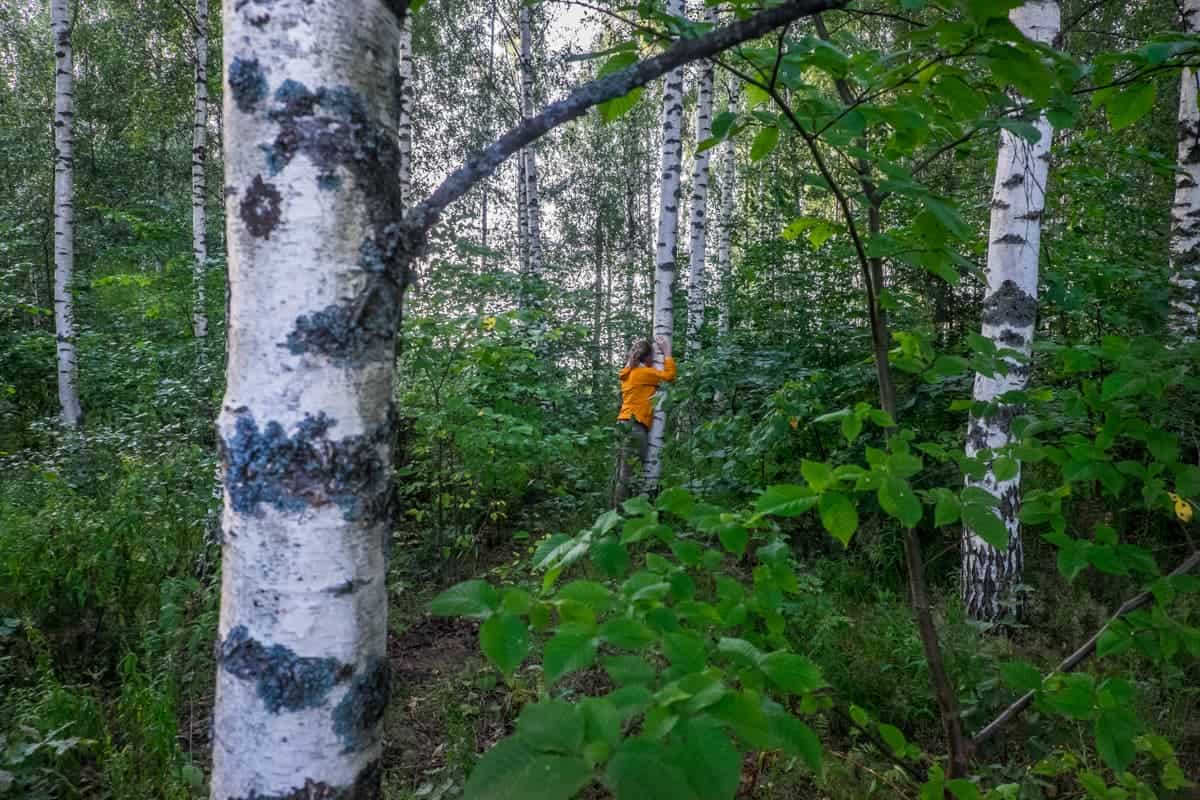
Tree hugging is part of the experience on the Latvia Grand Oaks Hike
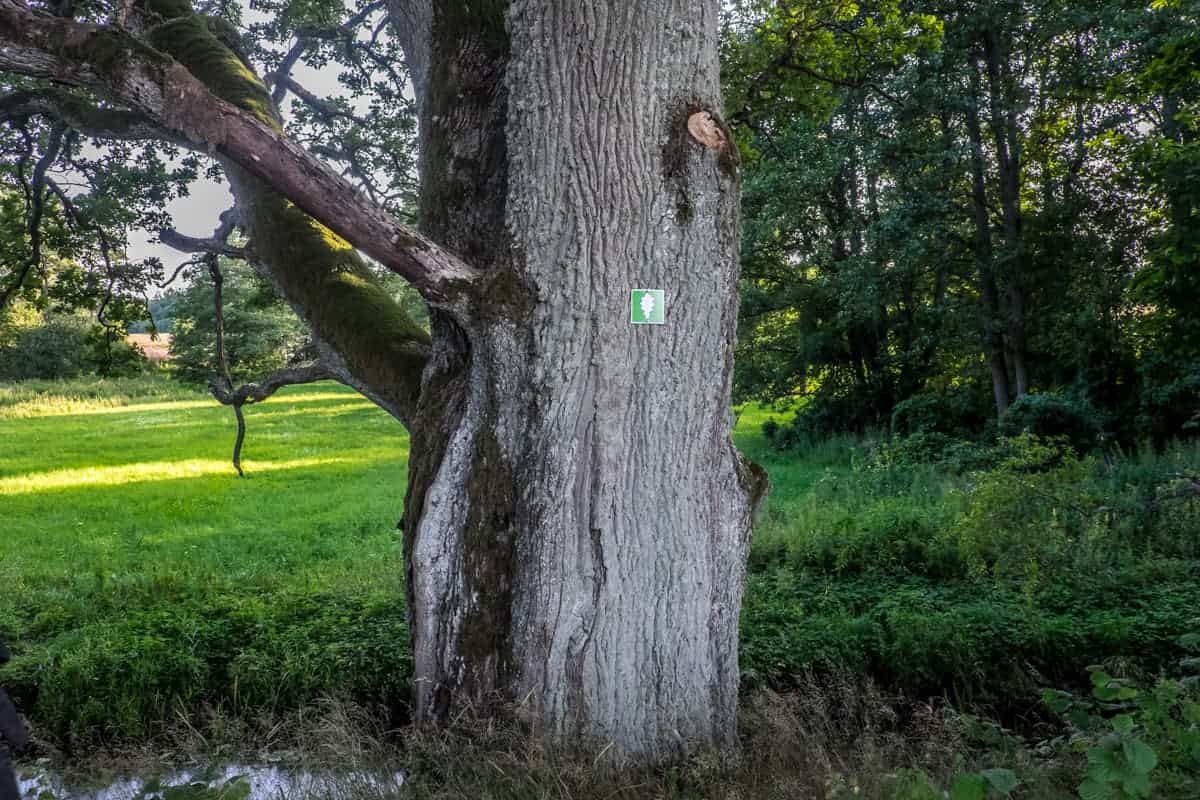
The Grand Oak trees are signposted and marked with a green symbol as part of their preservation and showcase
The sign highlights that everyone must walk on a straight path towards the trees – allowing responsible access and maintaining protection of this beautiful area. These rules must be followed, even if you visit outside of a small and organised group.
‘The Grand Oak Tour and Latvian Mythology and Fire Ritual’ experience with The Latvian Element is €70. You can book a time and date here.
Ērgli (South of Līgante)
You might not think to add Ērgļi to your itinerary, but you might want to consider it. While geographically not a part of Gauja National Park, it is within easy driving distance to it, located south of Ligatne.
Exploring the area surrounding the former 1937 constructed train station of Ergli with famous storyteller and Latvian TV personality Māris Olte is a highlight for anyone wanting to learn about the regeneration of an area through the eyes of a local.

Walking with Latvian personality Māris Olte in the countryside of his hometown, Ergli
Visit ‘The Station’ – Reclaiming Latvia Nature
Māris purchased the abandoned building and transformed it into ‘Station’ – a restaurant and hangout space used as a base to encourage people to visit his hometown, enjoy the landscape and sample the local produce.
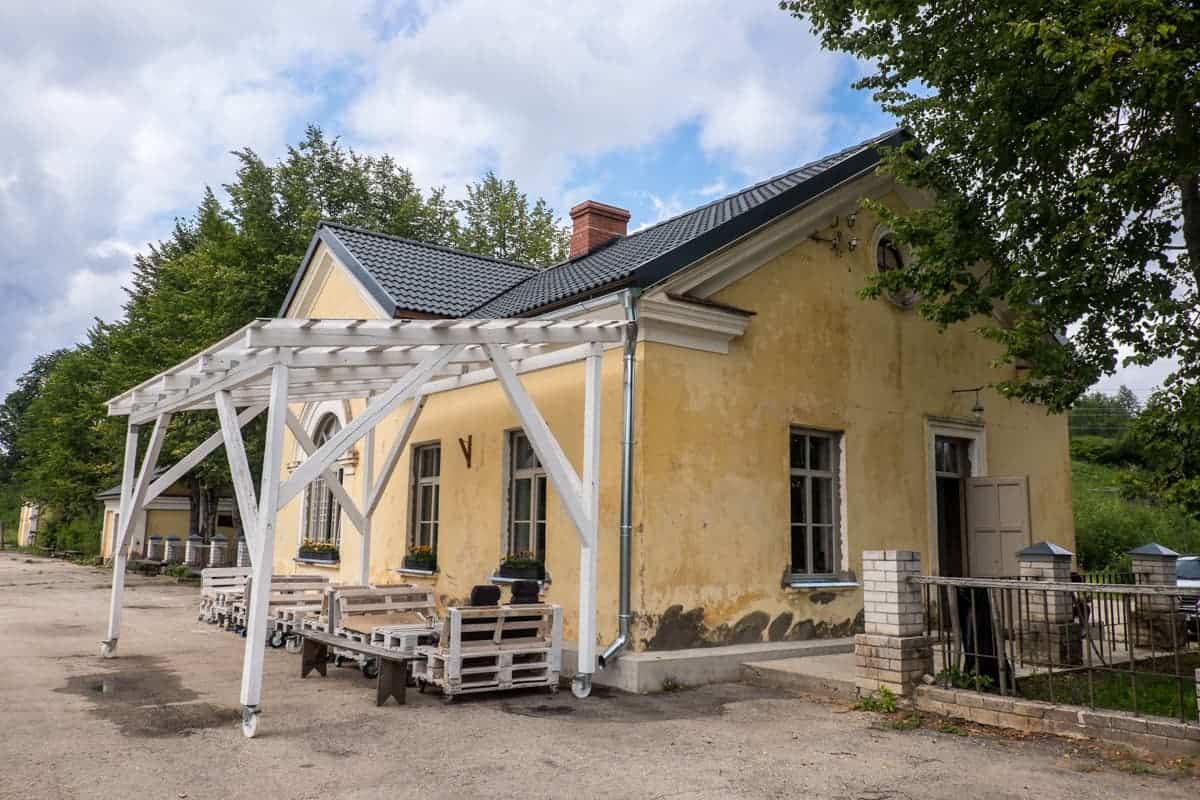
The renovated railway station in Ergli, Latvia
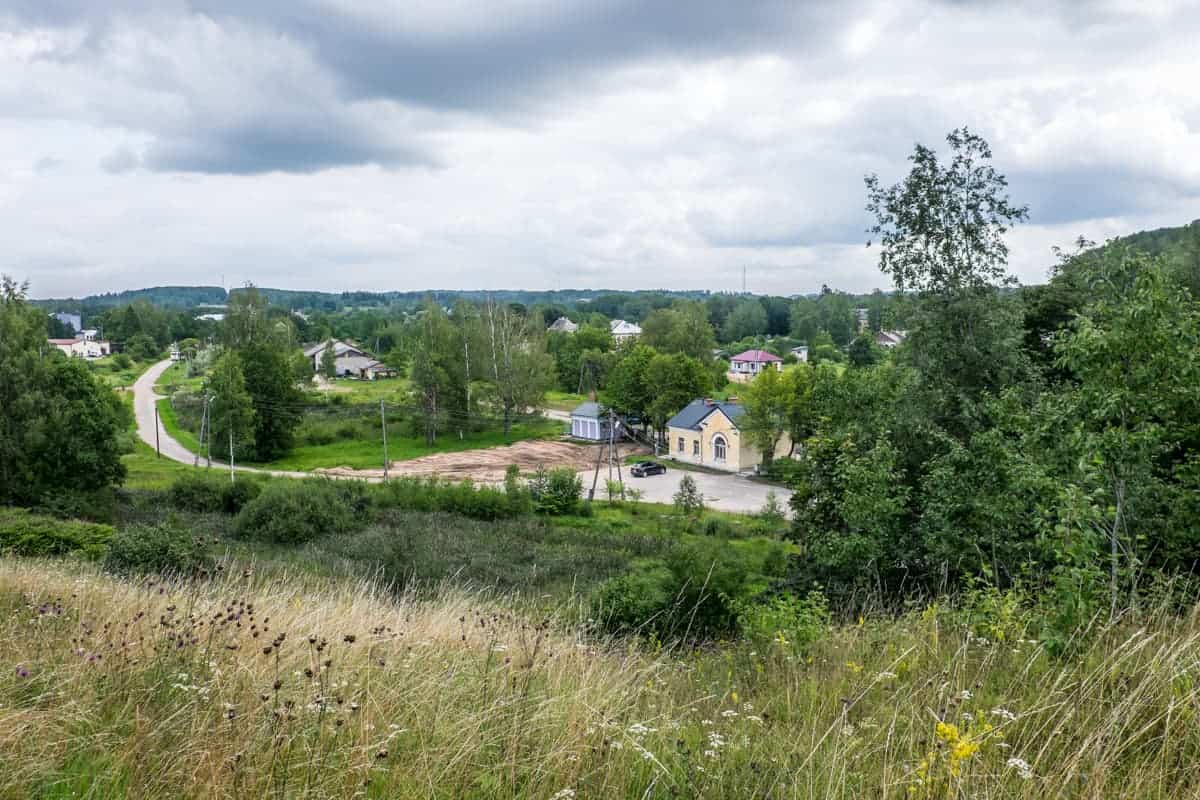
The land surrounding the ‘Station’ property in Ergli, Latvia – the latest nature immersion experience you can try
We spent some hours walking in the hills overlooking the dense forest before walking down and getting into the heart of the woodland, picking and eating nuts and berries in the little-trodden land Maris owns and cultivates.
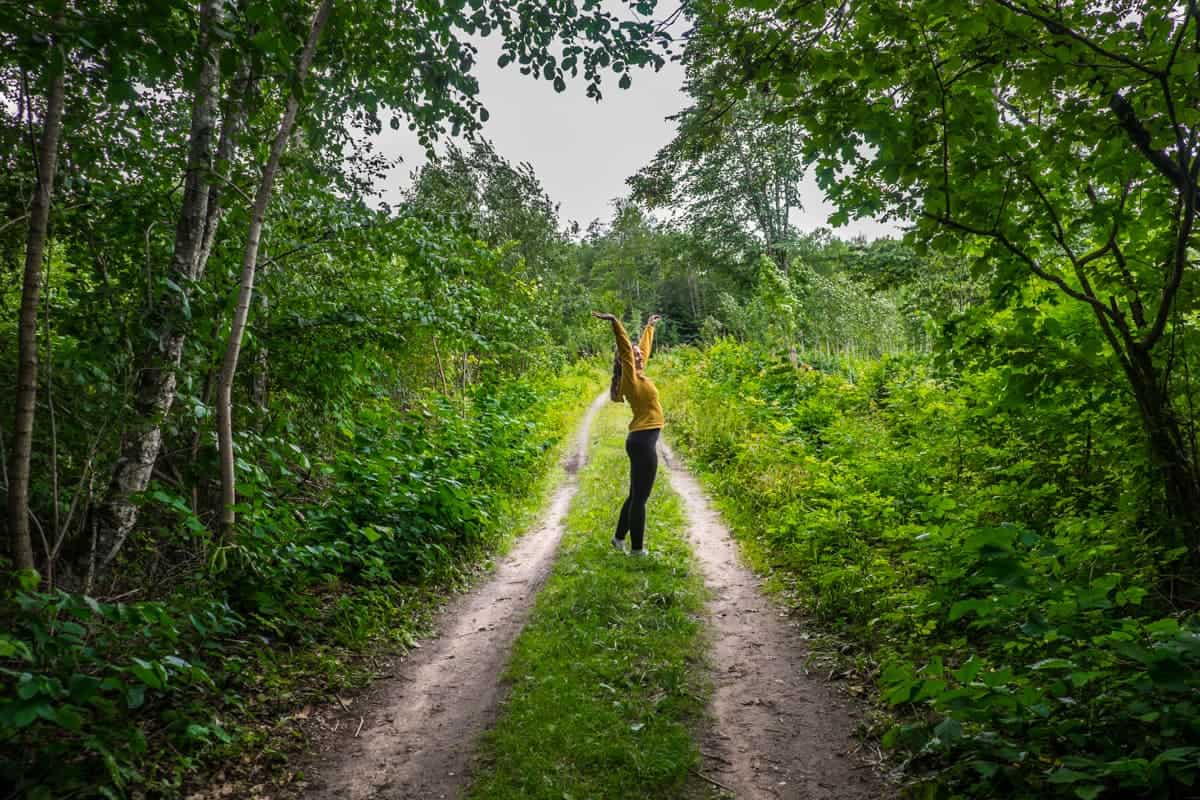
The happy feelings of being in nature in Latvia

Māris Olte taught us about what grows in the forest as we walked on nature trails in Ergli
See-Through Canoeing
Eventually, we came to the lake, where we took to a see-through canoe for a peaceful glide through the still waters, gently cutting through surface plants and water lilies. This lake is only accessible via Maris and his tours of the area.
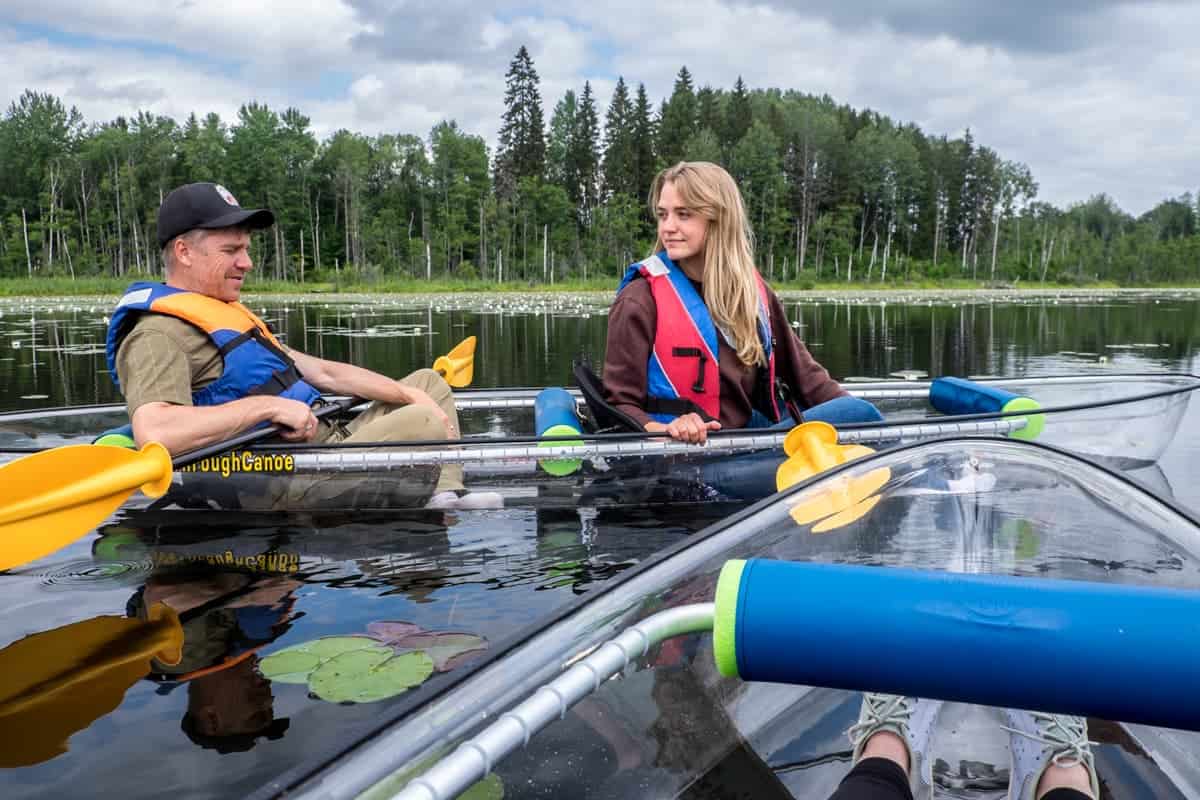
The incredible see-through canoe experience on a small lake in Ergli, Latvia
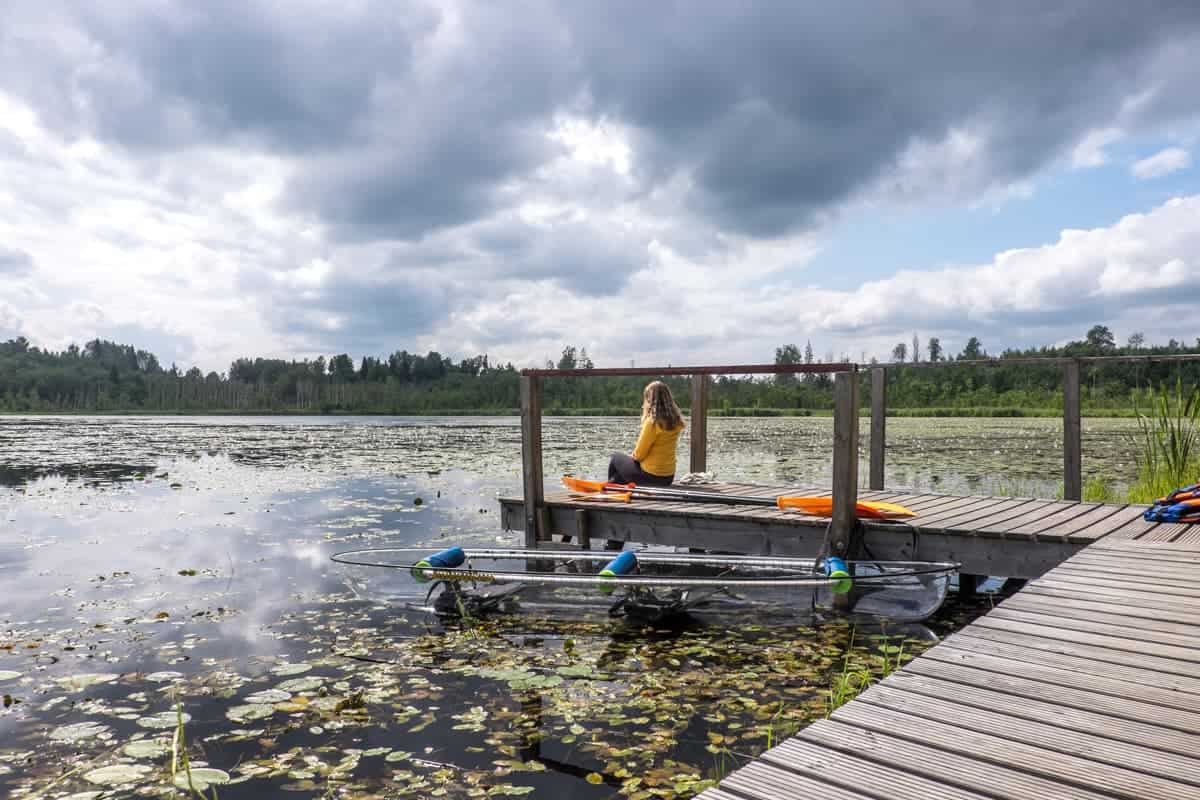
Lake time in Ergli, Latvia. Nature is always on show.
It’s worth noting that the newly established Green Railway route – a sign-posted biking trail through the countryside with 21 points of interest – passes through Ērgļi as it follows the tracks of the old railway lines. Supported by Maris, the renovated station is a prime stop for a local lunch.
Our exploration by foot meant needing to re-fuel before leaving for our next adventure, and so we feasted on fresh berries from the woods and perch caught earlier that day from the lake.

Cooking freshly caught perch with Māris Olte after our nature walk

Freshly caught berries and freshly baked cakes served up at the Station in Ergli
Lakes in Latvia – Waterside Living
Peaceful, scenic lake stops are a cornerstone of pristine Latvia nature and a perfect wind down from a few hours on the road – the Alauksta lake being the crown of water spots.
While these lakes are not geographically within Gauja National Park, they are beautiful areas within easy distance of it. These were often spots we visited at the end of the day or passed by in the morning before setting off for the next destination.
Alauksts Ezers (Alauksts Lake)
Alauksta lake is one of the deepest lakes in Latvia, reaching maximum depths of up to 7 metres, and is considered the most beautiful in Vecpiebalga country. Very much a local hideaway, it’s ideal for a cooling swim or to park up and wander its parameter of walking paths and shaded green areas.
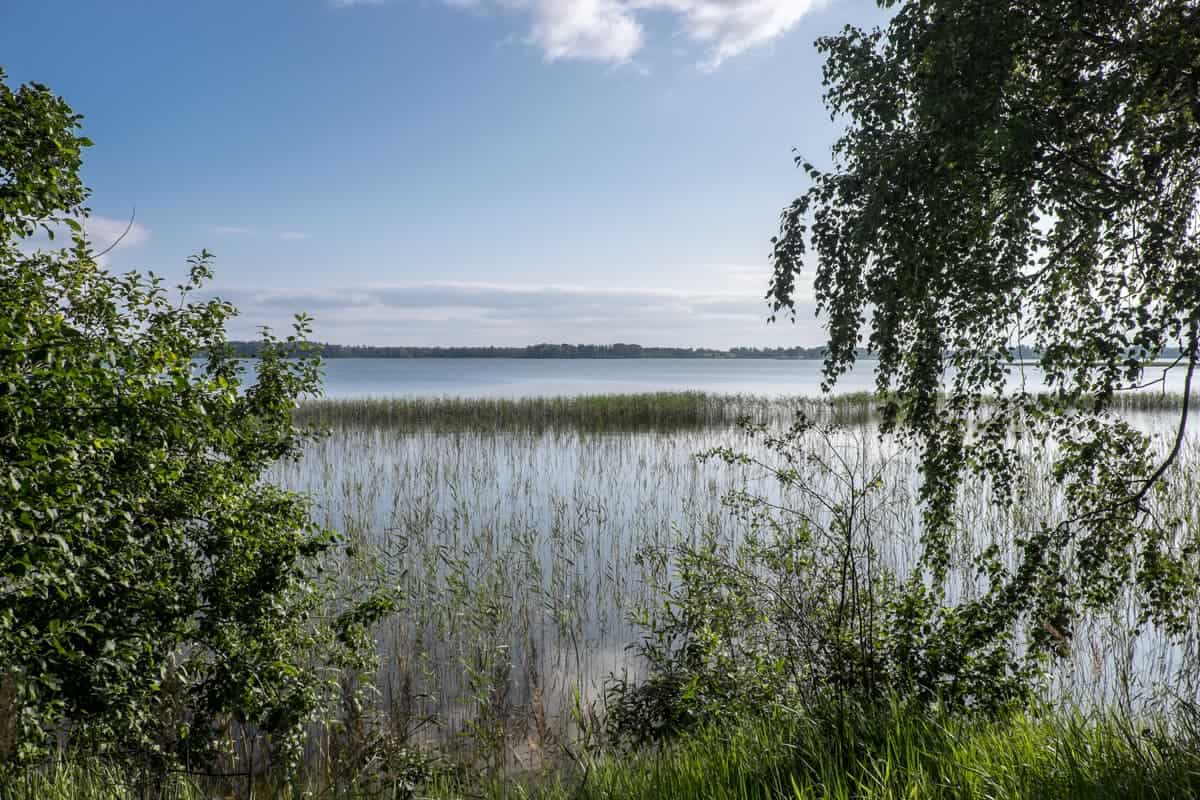
The vast blue waters of Lake Alauksts Ezers in Latvia, the country’s largest lake
Asaru Ezers (Asaru Lake)
Asaru Lake, which we combined with our trip to Ergli, has a backdrop temptation as you spot the tiny, tree-filled island that sits within it. We were tempted to take a morning swim but had to drive to our next destination.
This is the beauty of Latvia’s lakes, they are a beautiful rest and recreation spot at any point of the day, whether for sunrise or sunset reflections, bathing, or to find an isolated spot for nature immersion.
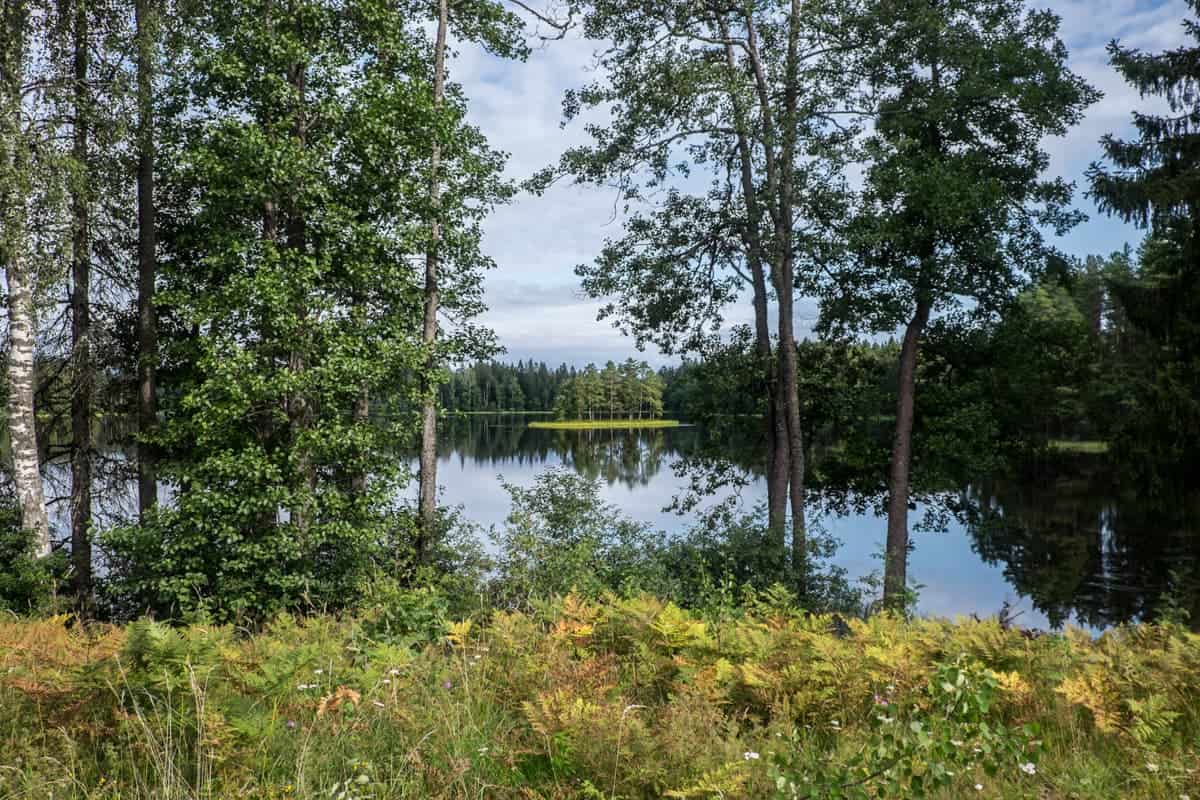
Want to swim out to the tree island on Lake Asaru Ezers? Latvia’s natural baths are inviting.
Cēsis
Cēsis Town
Cēsis may be compact, but its creamy pastel-hued streets and boho hangouts are inviting for a slow travel day. Red brick and traditional wooden architecture stand side-by-side, many of whose spaces are filled with cosy cafes and independent stores.
Latvia’s Most Famous Castle
However, many come here to visit the Medieval Cesis Castle – the most well-known and best-preserved castle ruins in Latvia.
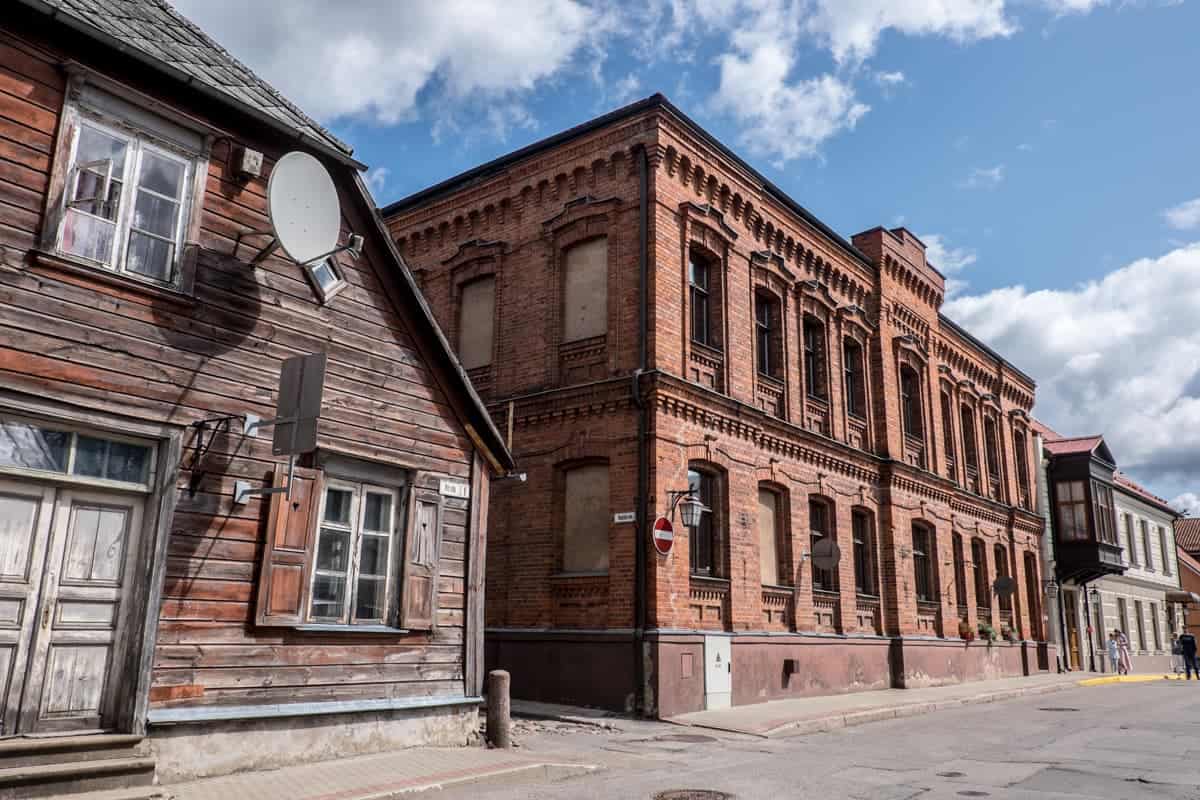
The beautiful streets of Cēsis, Latvia
A compact circuit that takes you around the castle complex and through various exhibitions, we mostly enjoyed climbing the 16th-century interiors of Western Tower up to the Master’s Chamber and other rooms.
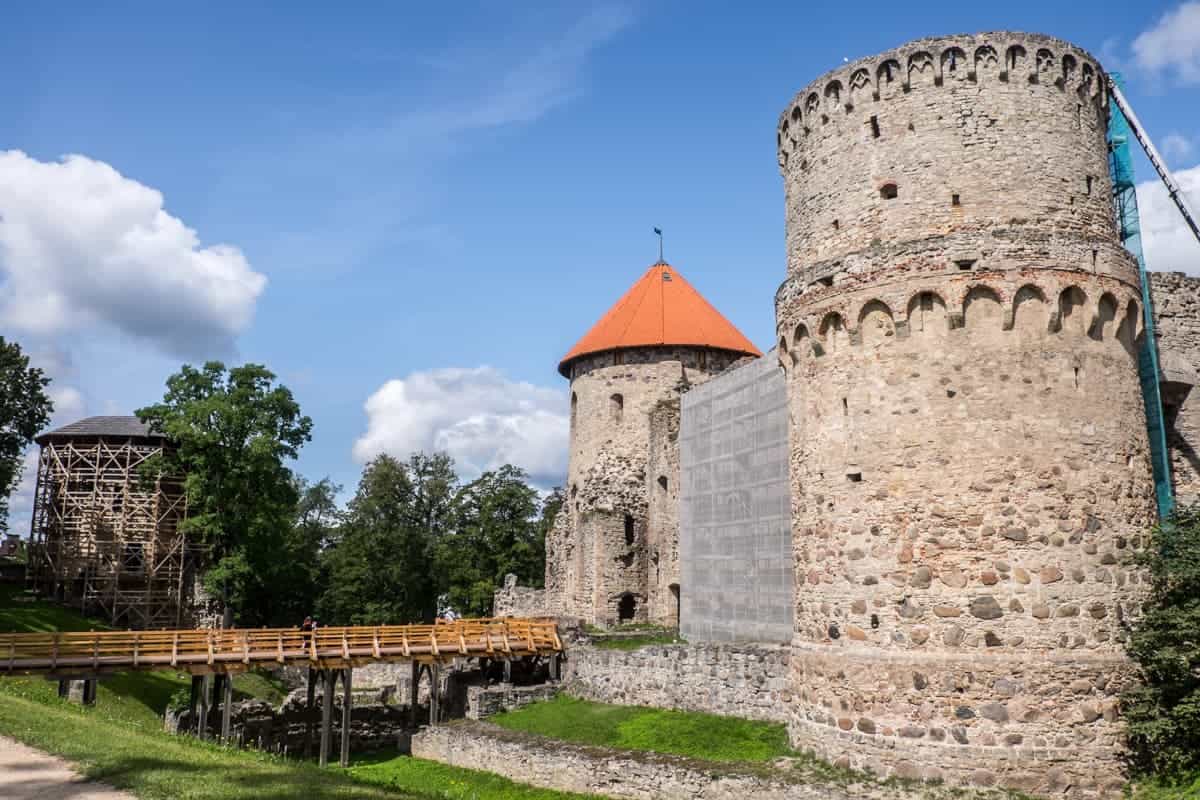
Latvia’s best known and best-preserved castle – The medieval Cesis Castle
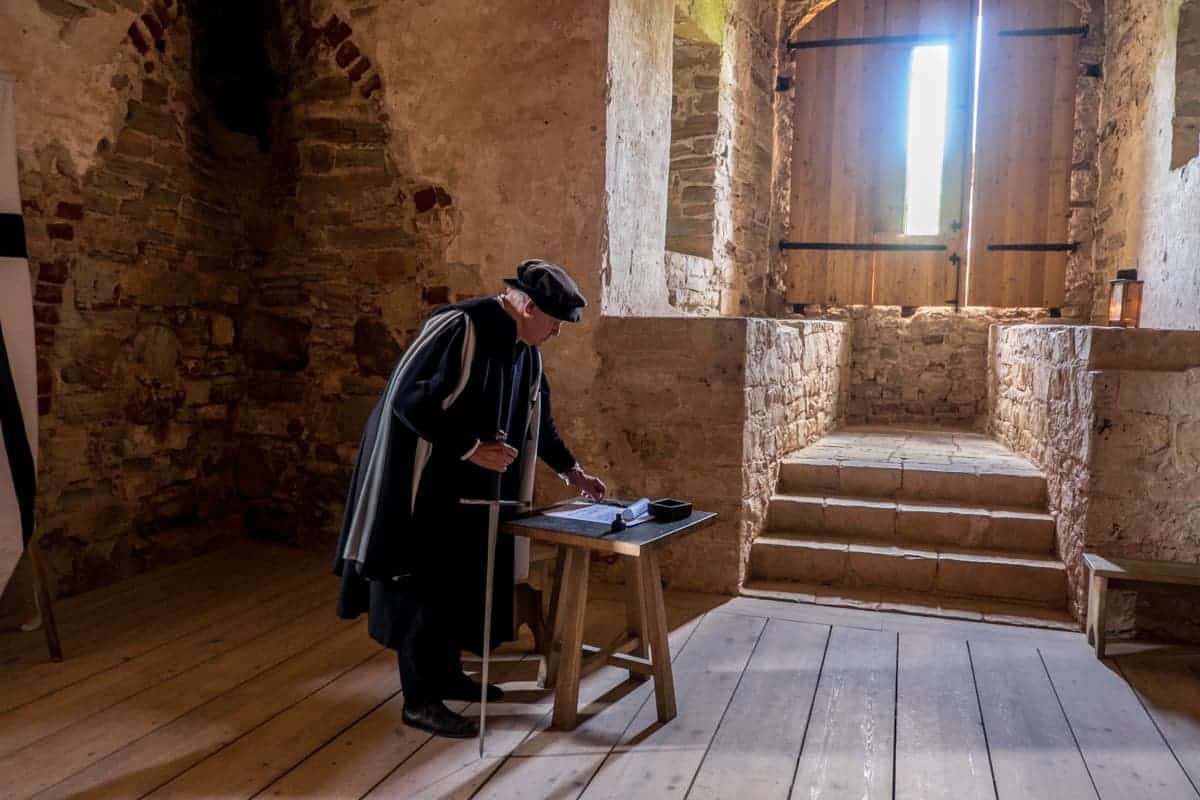
Visit the master in the chambers in the Western Tower of Cesis Castle
An interactive, multimedia wall-projection video plays in one room, detailing the history of the castle in sound, colour and visual artistry. You will also find the best viewpoints of the castle at varying stages on this climb that look out over Cesis since the castle is situated in the city centre.
Sigulda
Sigulda’s placement in being closest to Riga while being set within the Gauja valley means there is no excuse for it to be missed on a round trip from the capital. There’s a lot to see and do in Sigulda, which makes it a good overnight base. Wander through woodland and greenery, fortresses and cultural monuments or soar high above the valley bed by cable car and zip line.
Sigulda Cultural Highlights
For those with time, the cultural highlights include the Sigulda Livonian Order Castle, Turaida Museum Reserve and the Walking Stick Park.
Livonian Castle is a fortress from 1207 that was a base for crusading knights and later served as a convent. The Turaida Museum is the most visited museum in Latvia and a protected cultural monument comprised of houses, churches and the Turaida Stone Castle – a living history of the past 1,000 years of Latvian heritage. The Walking Stick Park is a tribute to the 200-year history of Sigulda’s most popular souvenir when walking trips in Sigulda gained popularity in the 1920s and ’30s.
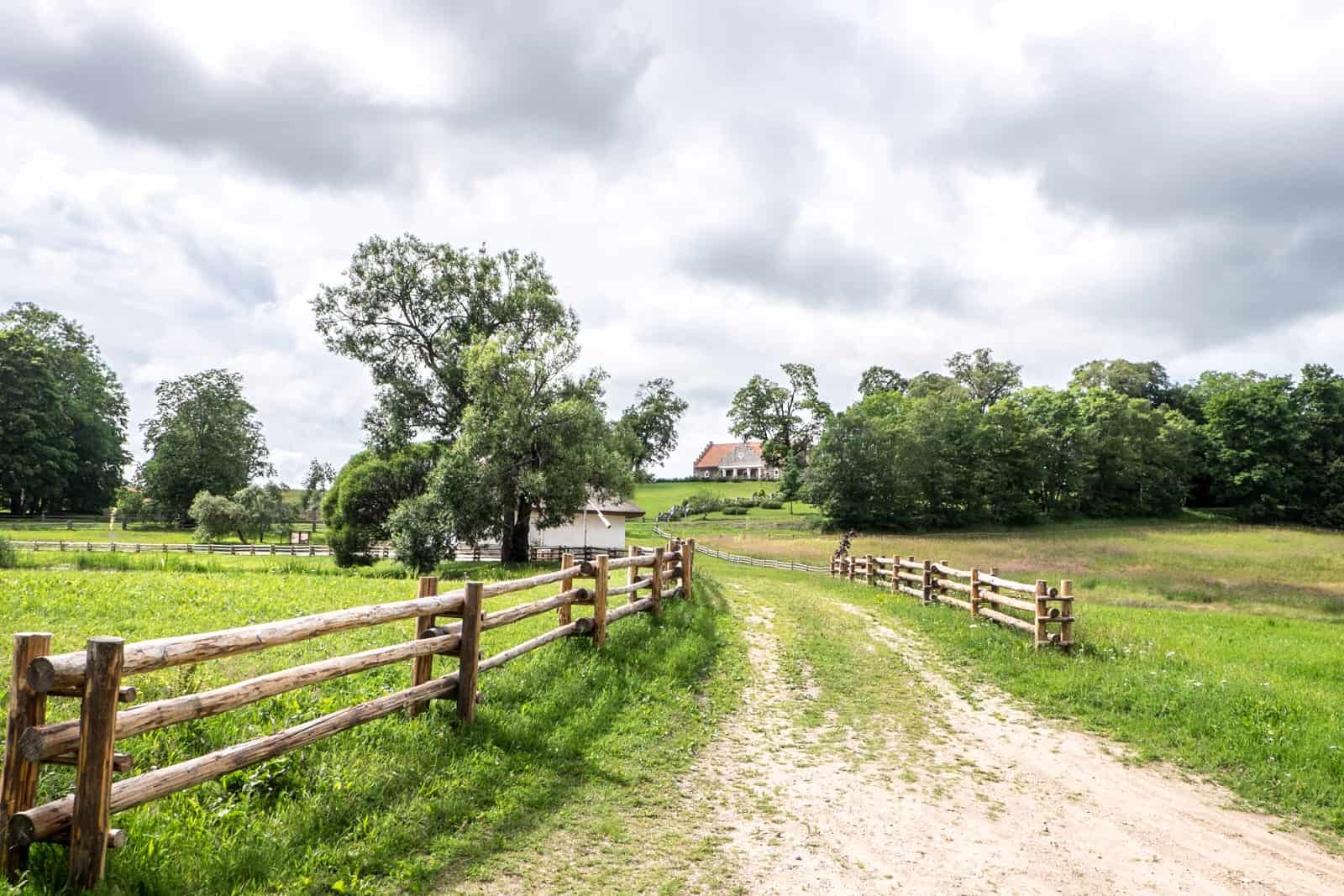
The landscape and structures of the cultural monument, Turaida Museum in Sigulda, Latvia
Sigulda Adventure Highlights
For something more adventurous beyond a slow wander in the green and around Krimulda Manor (an 1848 house turned rehabilitation centre) after taking the 42m high cable car from one side of the valley to the other, there are some adrenalin options.
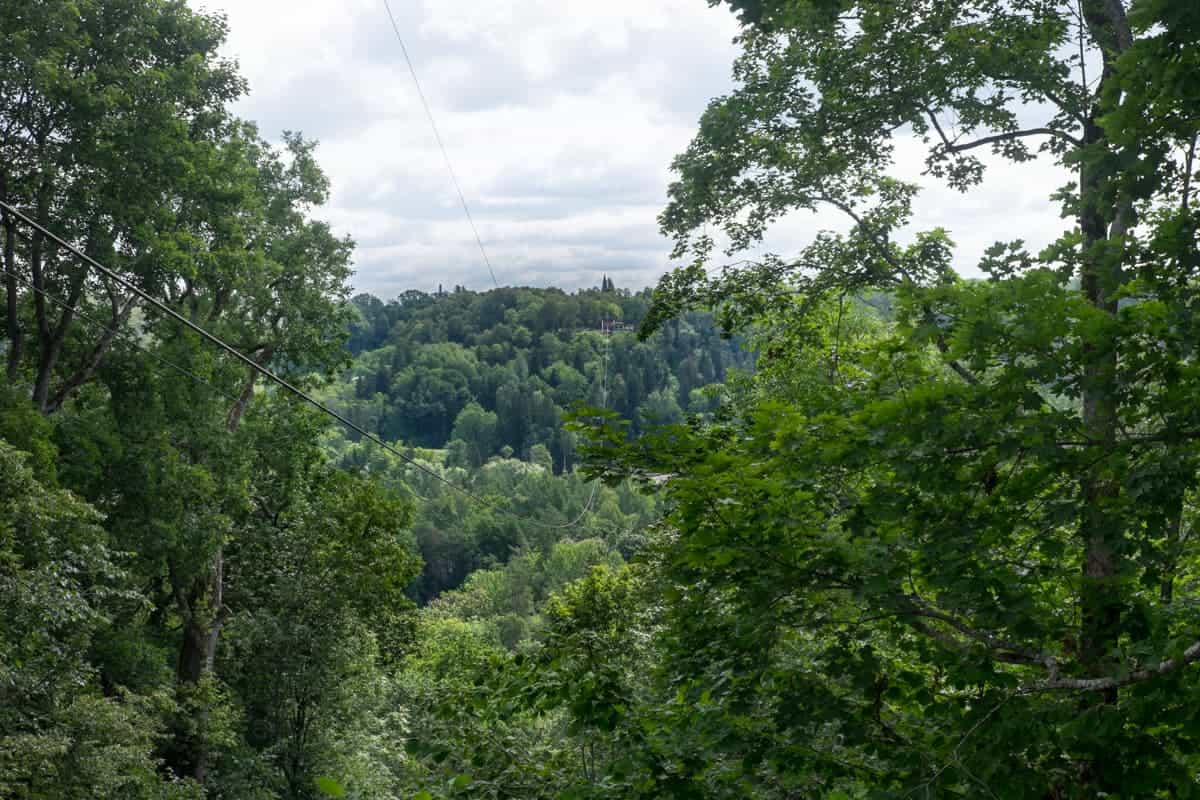
The cable car across the dense Gauja National Park forest valley in Sigulda, Latvia
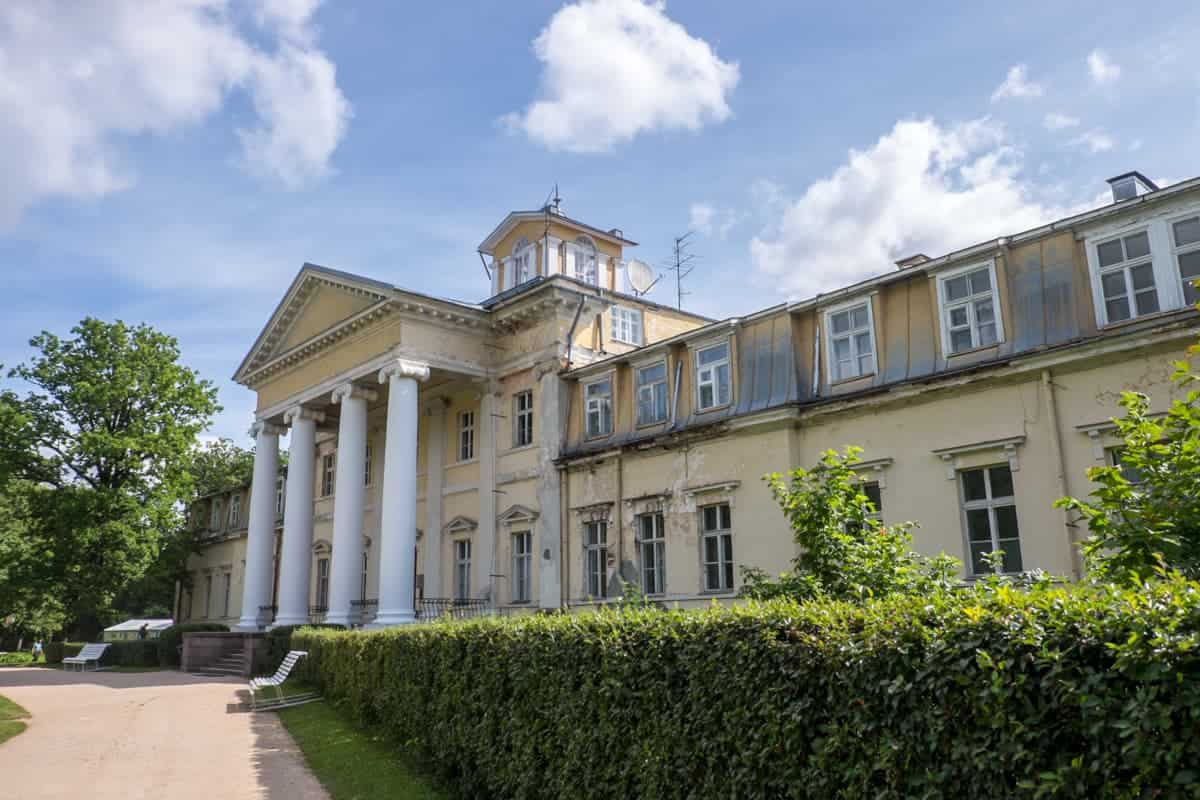
Wander the grounds of Krimulda Manor in Sigulda
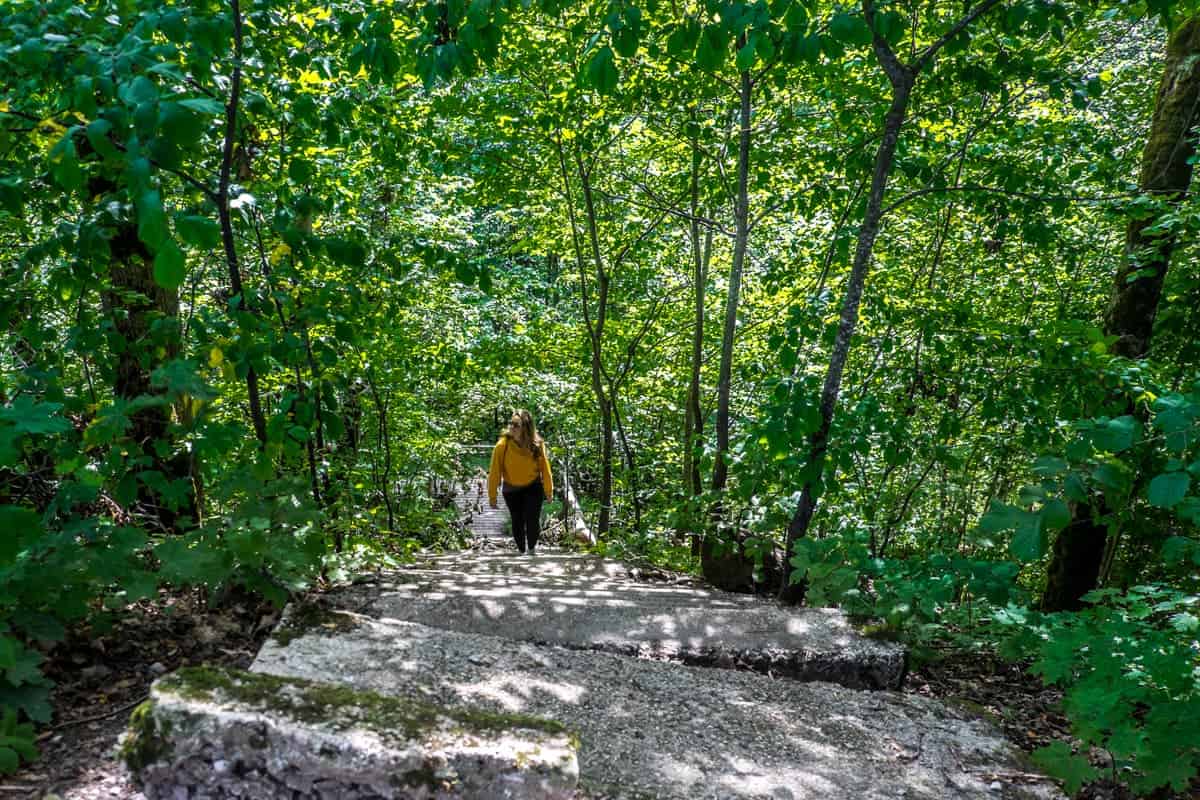
Sampling part of Sigulda’s hiking trails
Namely, the zip line that runs on a parallel line above the car or the bungee jump off the cable car. Below in the valley, swings, jumps, zorb balls and catapults can be found in the Adventure Park Tarzan or Latvia’s Bobsleigh track take you on a journey with speeds of 80 km/h on this Olympic track with 16 turns.
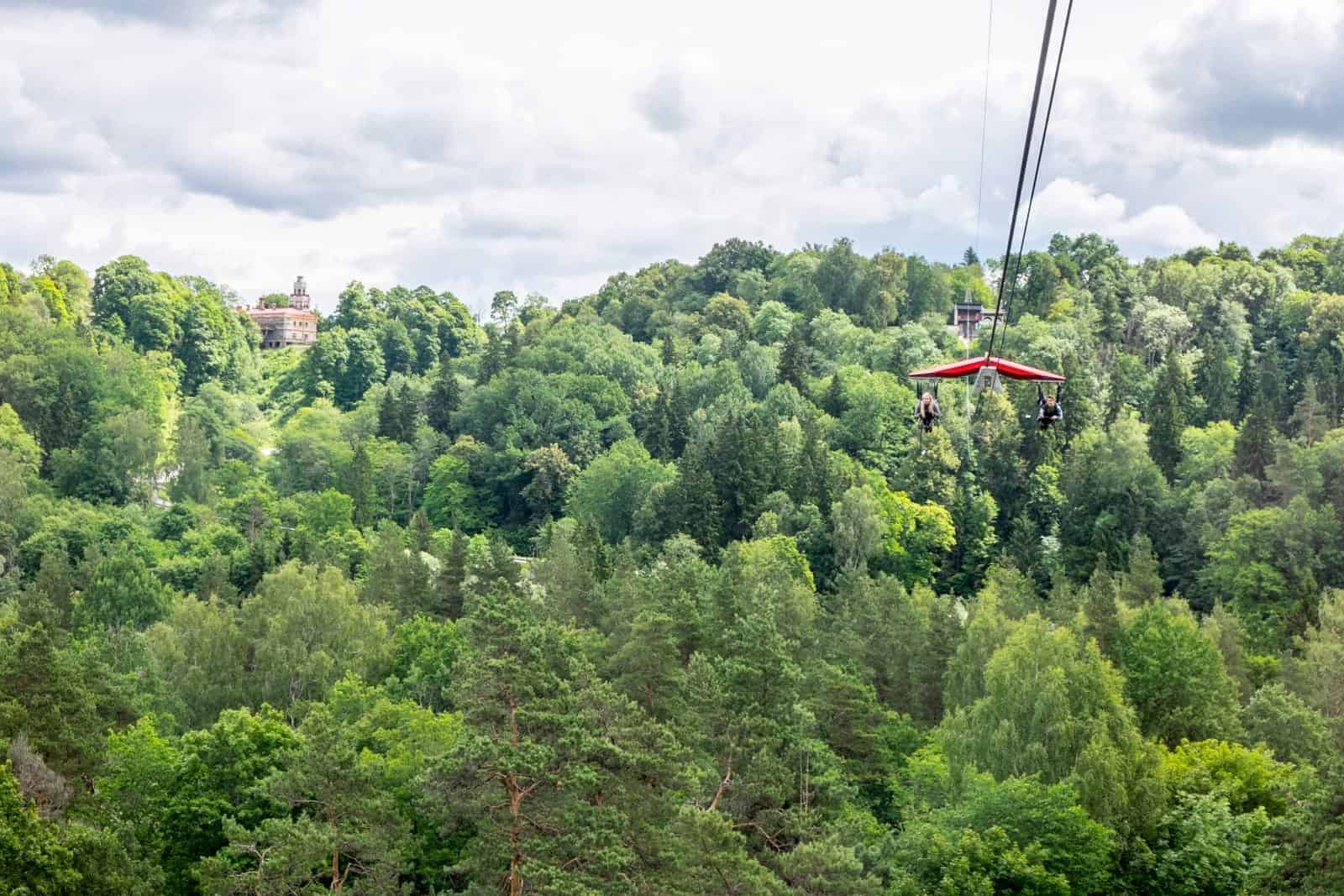
The zipline in Sigulda – one way to view the nature haven of Gauja National Park from above
Sigulda Nature Highlights
Hiking in Latvia is possible in Sigulda. A 7 km hiking trail runs through woodland and eventually brings you to the 10,000-year-old Devil’s Cave. If you don’t have much time, you can drive on a narrow, bumpy pathway that leads down to the River Gauja and the cave, park up and walk for around 10 minutes on the signed tracks to the pedestrian Kajnieku Bridge. If you cross it, you will have a better view of Devil’s Cave and the nature that engulfs it.
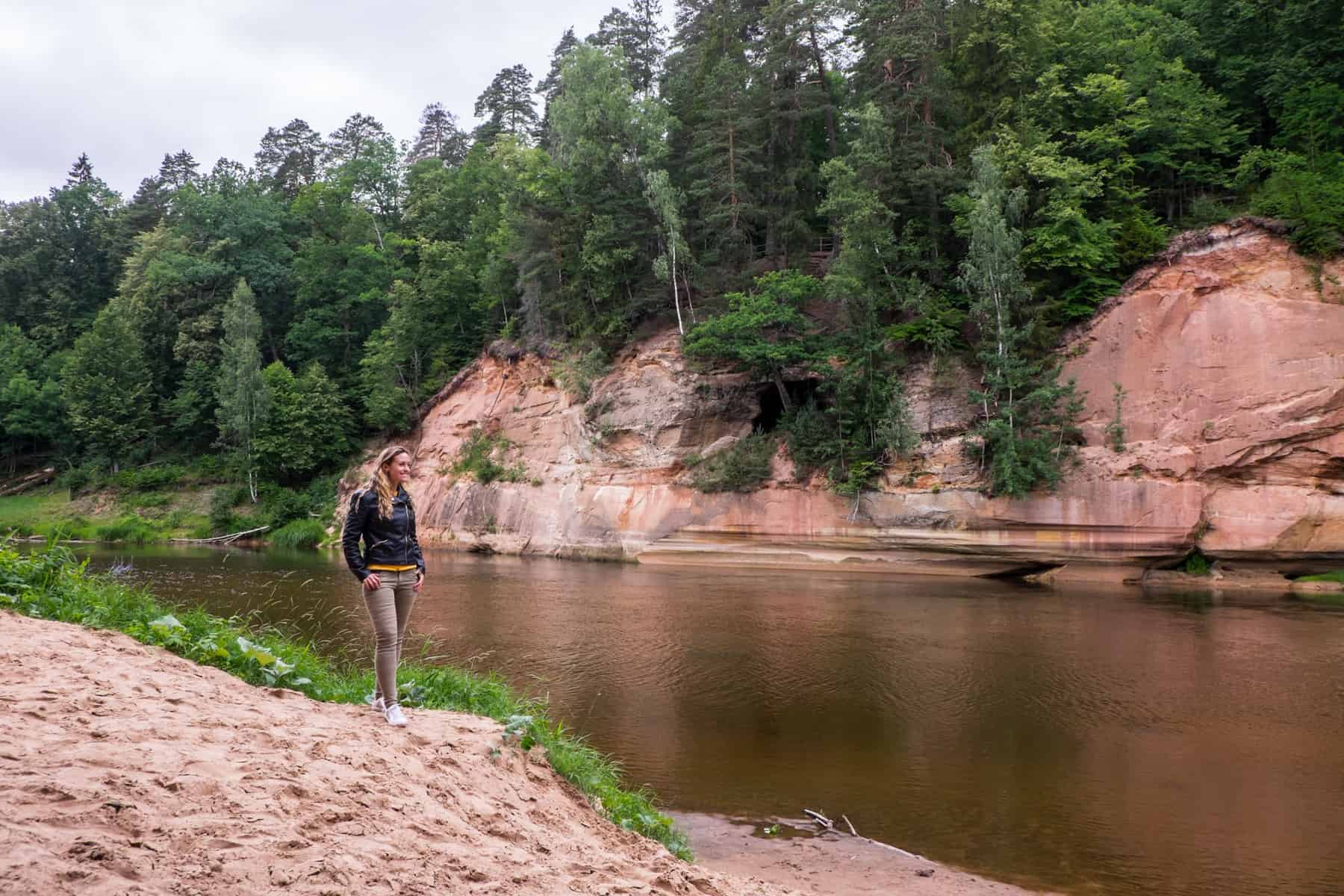
Sigulda’s 10,000-year-old Devil’s Cave.
More accessible is Gutman’s Cave, which is just metres from the main road that runs through Sigulda and at the opening of the woodland. It is the largest grotto-type cave in the Baltic States, with detailed wall inscriptions dating back to the 17th century.
BOOK: A full-day guided hike in Sigula, dubbed the Switzerland of Latvia, takes you through Sigulda’s nature and cultural attractions.
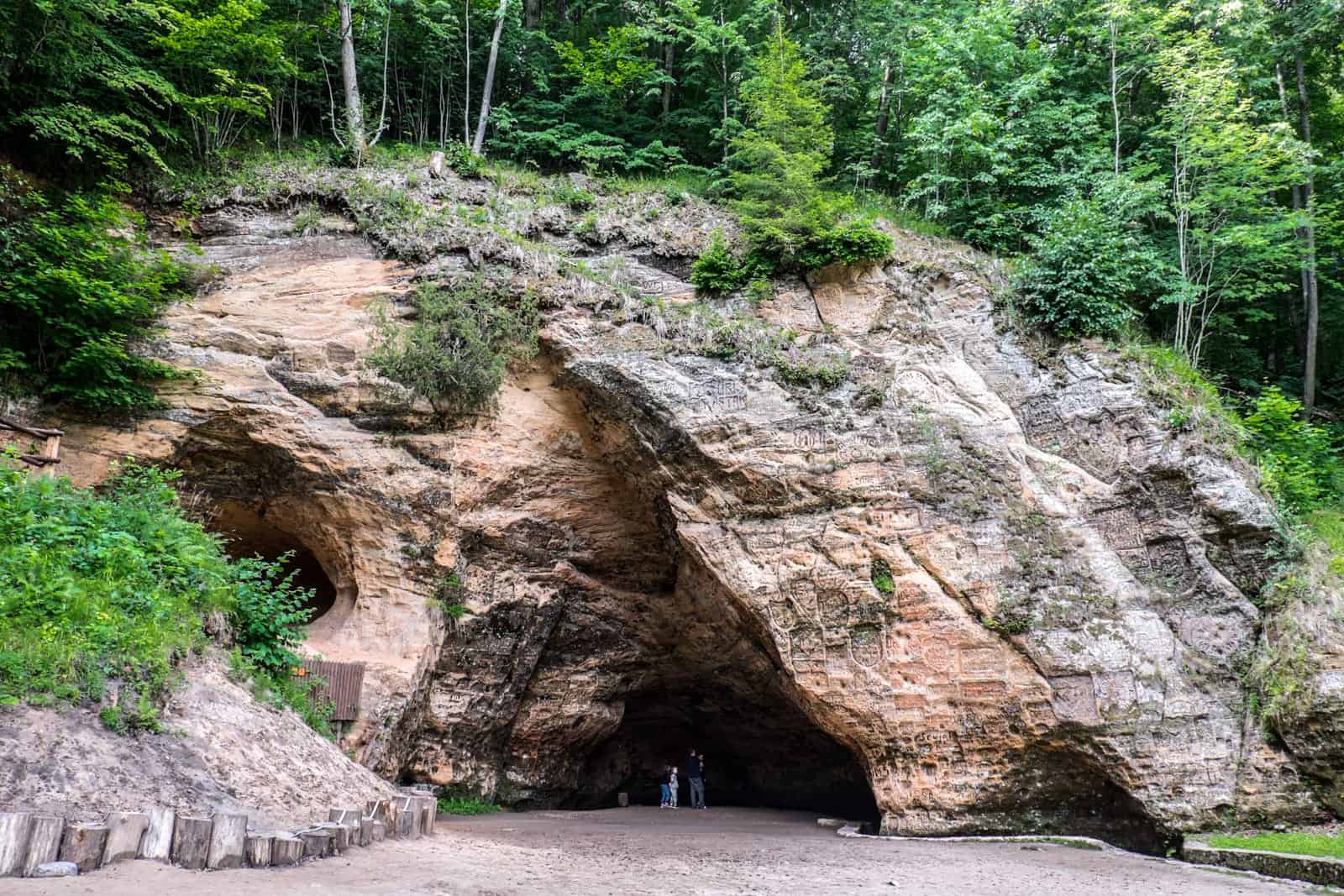
Gutman’s Cave, etched with inscriptions, found in Sigulda, Latvia
Planning Your Trip to Gauja National Park
Best Time to Go to Gauja National Park, Latvia
With free admission and open all year round, when to go to Gauja National Park comes down to personal preference on how you wish to view the landscape.
Spring sees the cherry trees in bloom, creating a white canvas; Summer means having the best weather for hiking, biking trails and sun-kissed lake canoe rides and bathing; Autumn sees the park turn into hues of golden brown, crisp orange and yellow as the leaves paint a new layer.
Do you want also to visit Riga as part of your plans?
READ MORE: Alternative Riga Travel Guide – Latvia’s Capital Beyond the Old Town
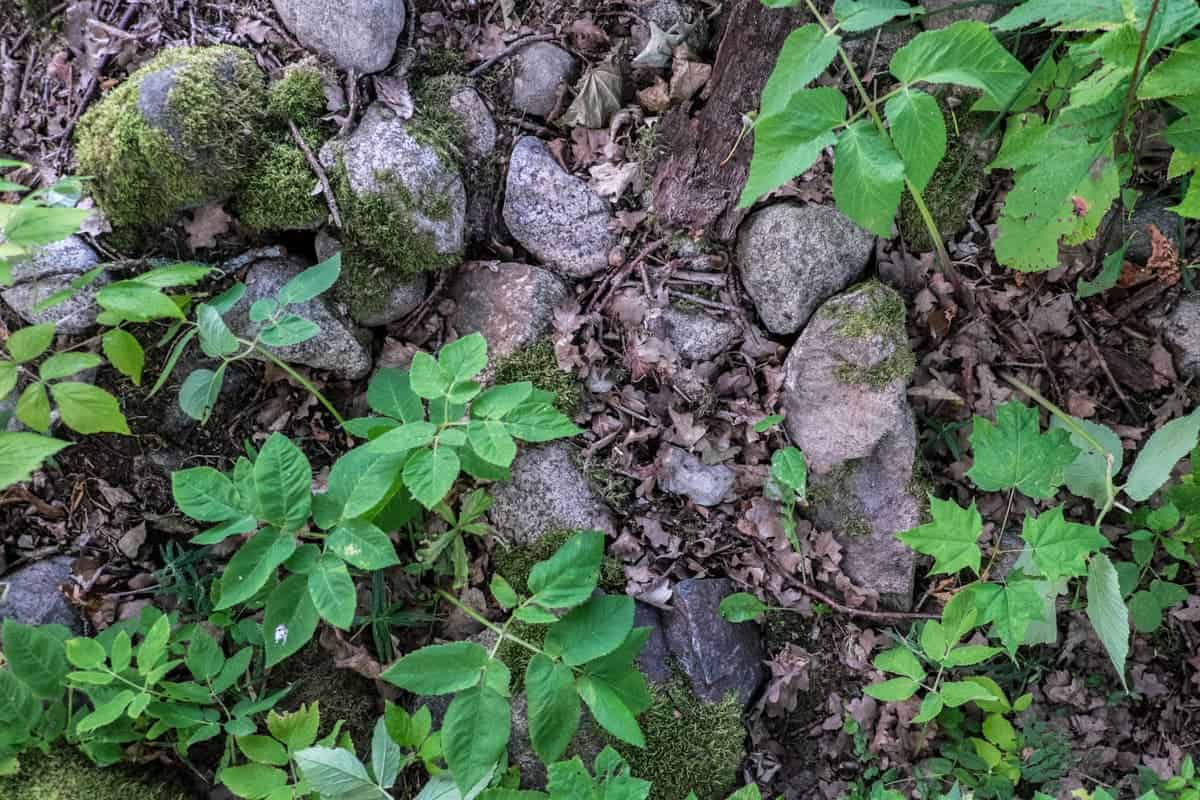
When to go to Gauja National Park depends on how you want to see it in bloom
How to Get to Gauja National Park From Riga
We hired a car at Riga airport and returned there after five days. We had full insurance on the car, knowing that we would potentially go off-road and find ourselves on dusty, gravel laden and dirty trails.
You can compare and book deals for car hire at Riga Airport here.
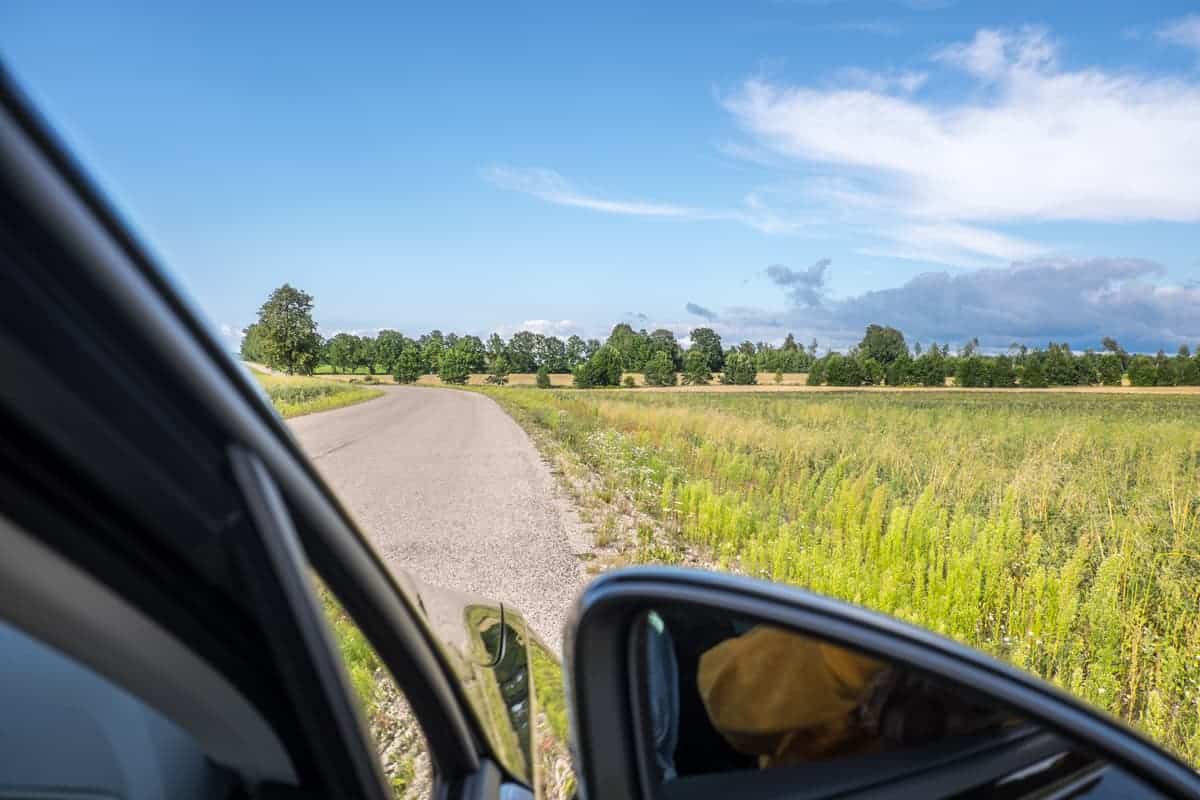
Road trip views when driving the gravel roads in Gauja National Park
Keep an adventurous spirit and have patience, as much of Gauja National Park can get tricky to traverse or find campsites in more isolated areas.
It pays to use more than one GPS when driving in Gauja National Park. Often our in-car GPS would give us a wildly different route than Google, and vice versa. Only on one or two occasions did we have to make educated guesses and use our instinct when we knew we were on someone’s land accidentally and turn around.
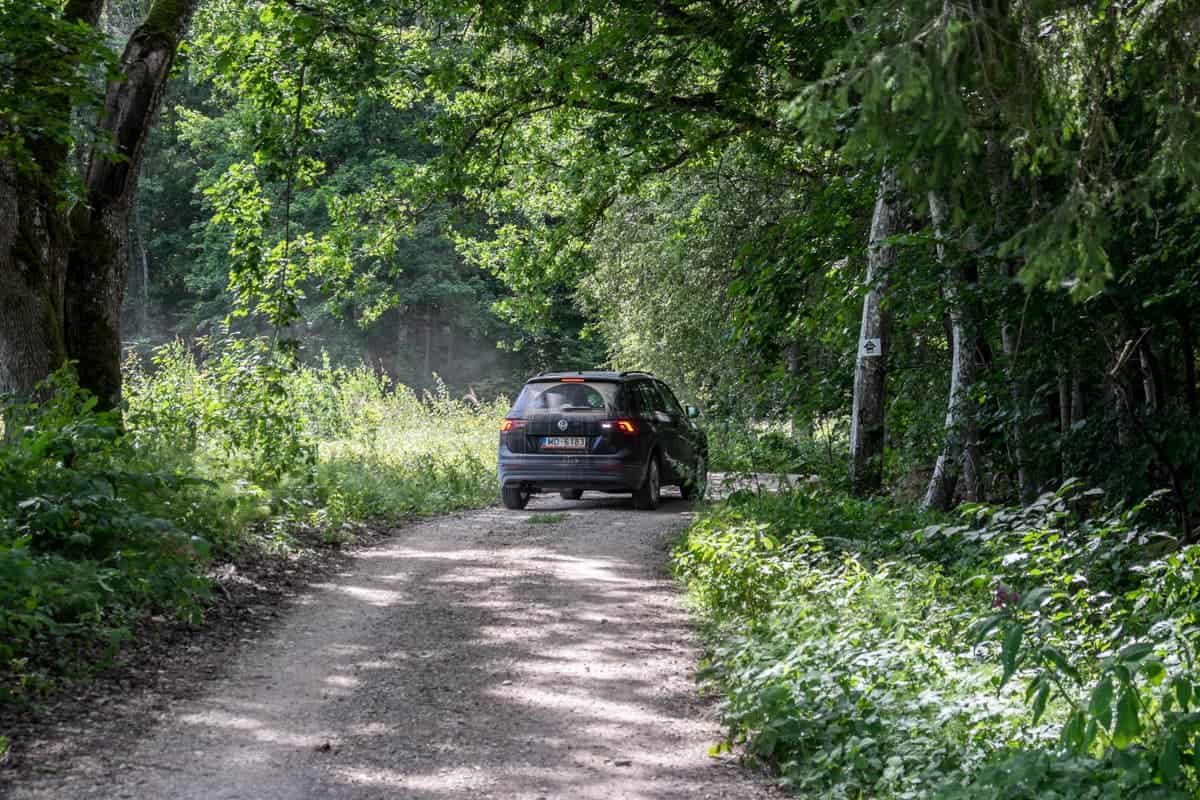
Driving in Latvian nature parks can mean getting off-track
Where to Stay in Gauja National Park
Ligatne Hotels and Campsites in Latvian Nature
Hotel Zeit is a former helmet factory repurposed into an artistic hotel and restaurant, Kafe Zeit. The chef, Oskars, likes to whip up a healthy and modern take on Latvian cuisine using produce from the neighbouring forests and gardens.
It has modern décor with themed rooms whilst retaining elements of the former interior and design, alongside swing chairs, a piano and funky artwork in corridors, common room and relaxation spaces. The hotel has an outdoor climbing park for small and big kids alike.
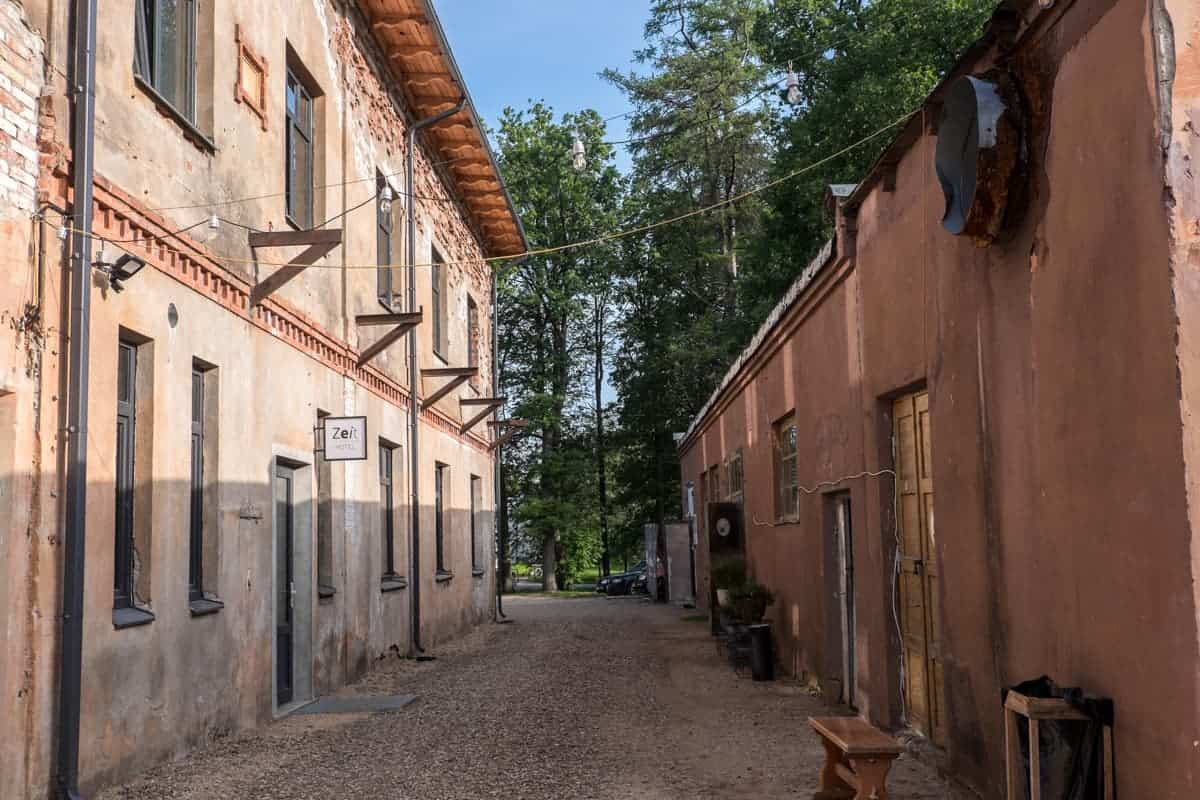
The renovated former helmet factory that is now Hotel Zeit in Lignate, Latvia
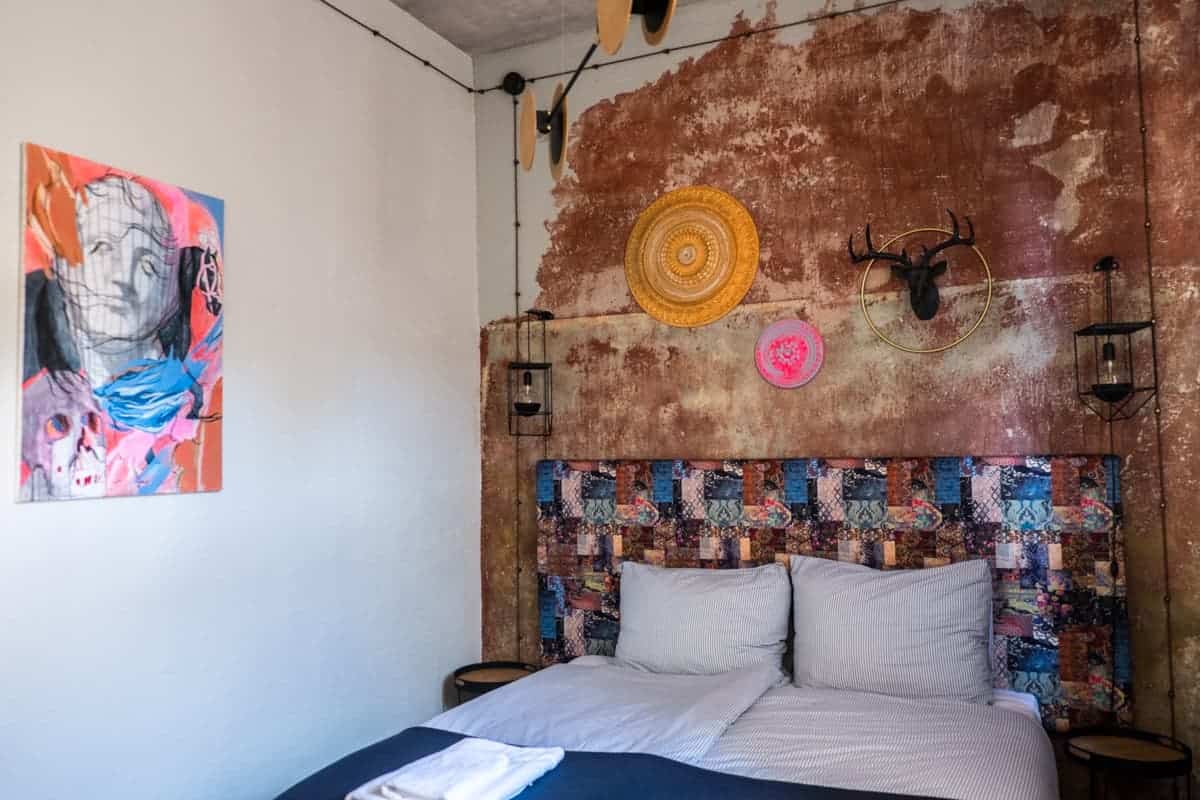
One of the themed rooms at Hotel Zeit
Igates Pils is a cultural monument as well as a place to sleep. A manor house castle with manicured gardens and a small manmade lake, it’s a beautiful place to visit and if you don’t want to stay over, it’s lakeside restaurant serves up high-end, modern Latvian cuisine.
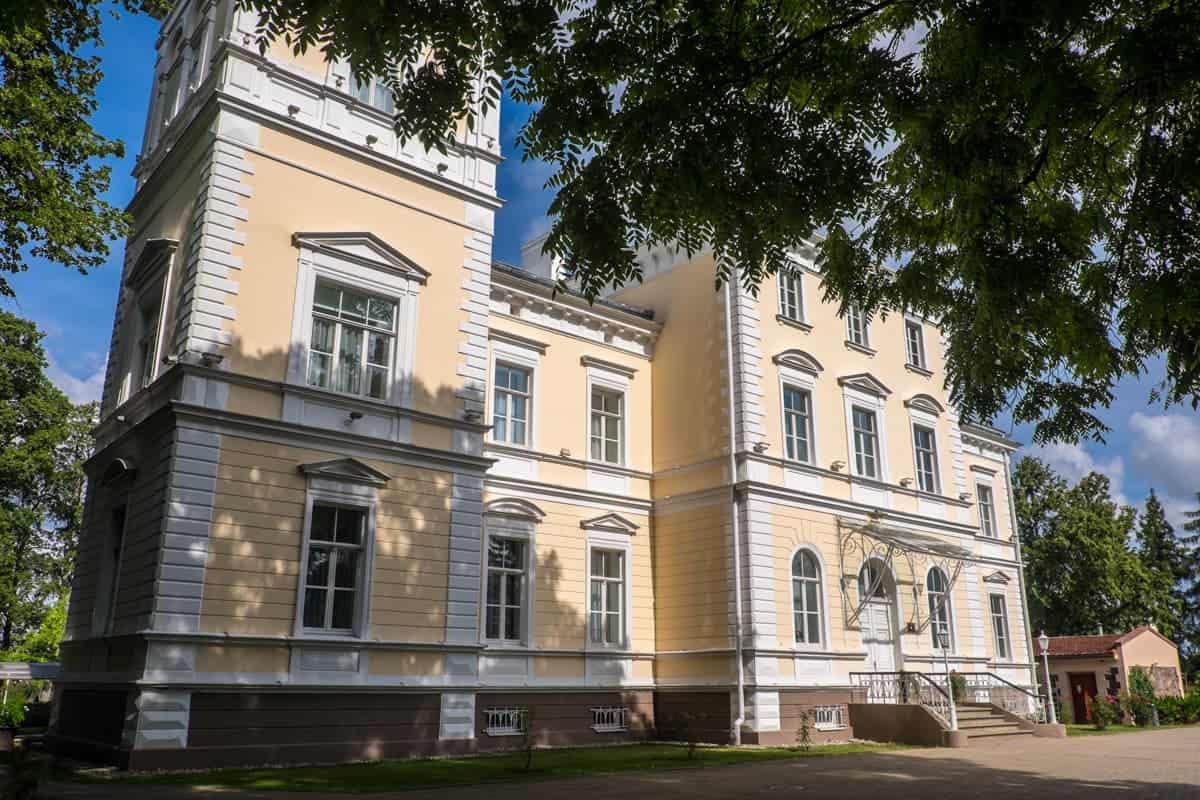
Latvian heritage in Igates Pils manor house hotel
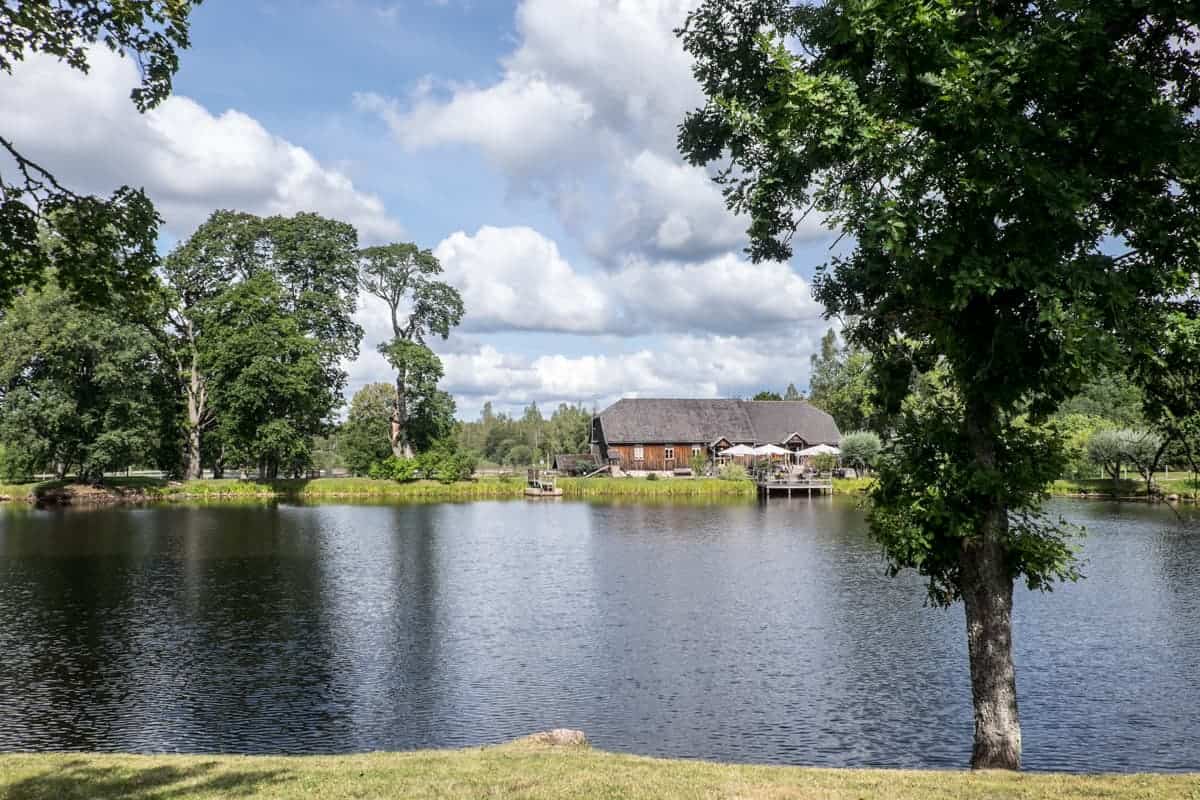
Lakeside views at Igates Pils
Līgatnes Zemturi is the traditional Latvian campsite where we both stayed and experienced the Latvian Bath Ritual. Located in an area called Venči, the wooden huts are homely, with basic facilities, but give enough comfort in a rustic natural setting.
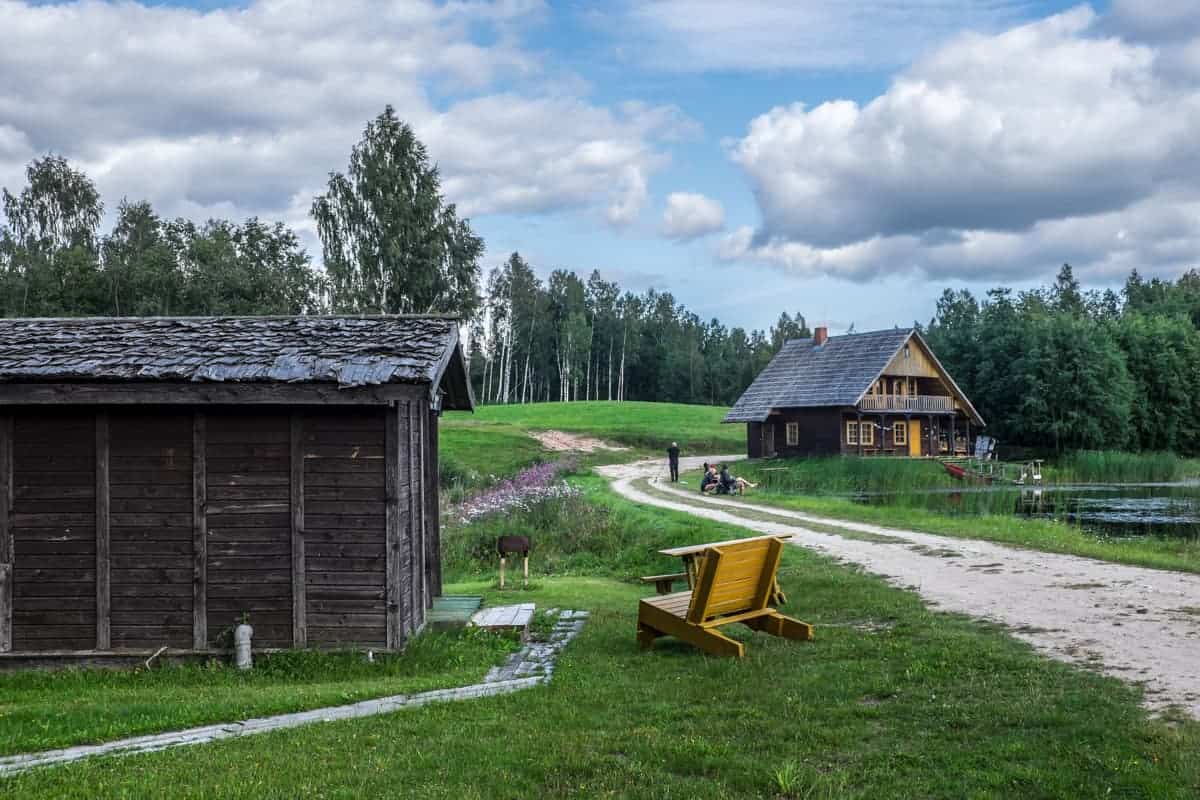
Untouched Latvia nature, best experienced by staying at a traditional campsite
Cēsis Hotels
Vanadziņa māja (Hotel Vanadzina’s House) is a modern, functional design hotel in a renovated old building. In the very centre of Cesis, you will be close to all the major attractions such as Cesis Castle Park.
Sigulda Hotels
Sigulda Hotel is an elegant building set in a leafy area close to Sigulda’s Castles and the famed Bobsleigh track. There is a restaurant serving international cuisine, and a swimming pool, sauna and steam room add to the relaxation after a day out in nature.
Resources and Further Reading
For further information check out the official Latvia tourism website to help plan and seek further inspiration for where to go and what to do. They helped facilitate our trip and map out our ideal road trip plans.
The Enter Gauja site also has a helpful trip planner, where you can save a list of sites and book experiences.
The Latvian Element is run by passionate locals who provide Latvia nature tours for those wanting more immersive experiences. Our Latvian Bath Ritual, Fire Ritual and Grand Oaks Hike were organised by them.
Gauja National Park Tours
This full-day Cēsis, Sigulda & Turaida Castle tour from Riga is a full-day trip covering highlights of the park and with medieval castles with a guide. The price includes hotel pick up and drop off, transport, guide and all entry fees.
Those looking for a day of adventure on Latvia’s rivers should consider the full-day River Kayaking Tour from Riga to Sigulda. You’ll journey on the Brasla and Gauja rivers to see the natural highlights up close.

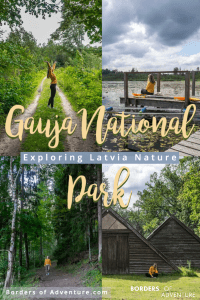

natalie says
It really looks like a beautiful place to visit. thank you for the idea!